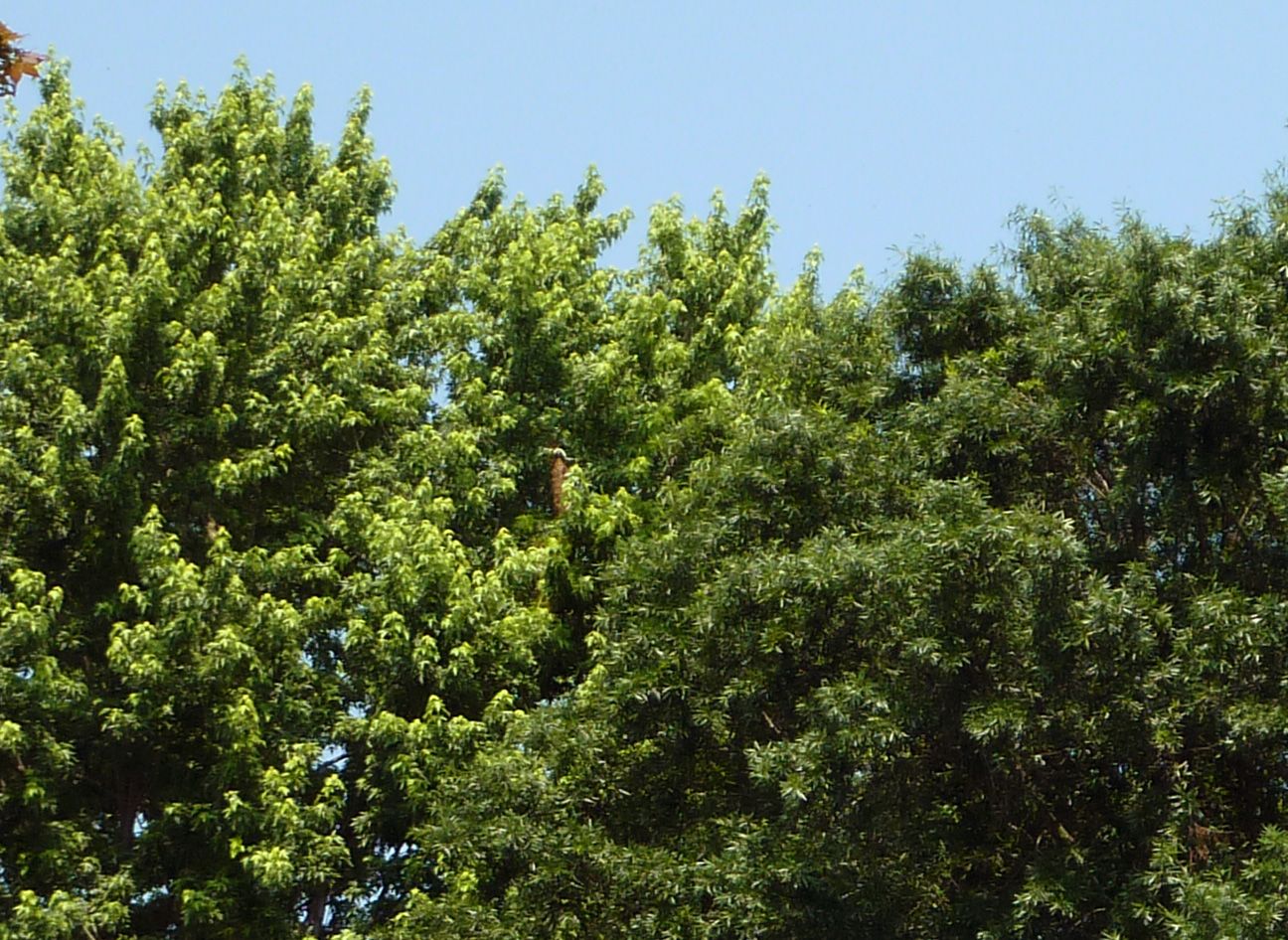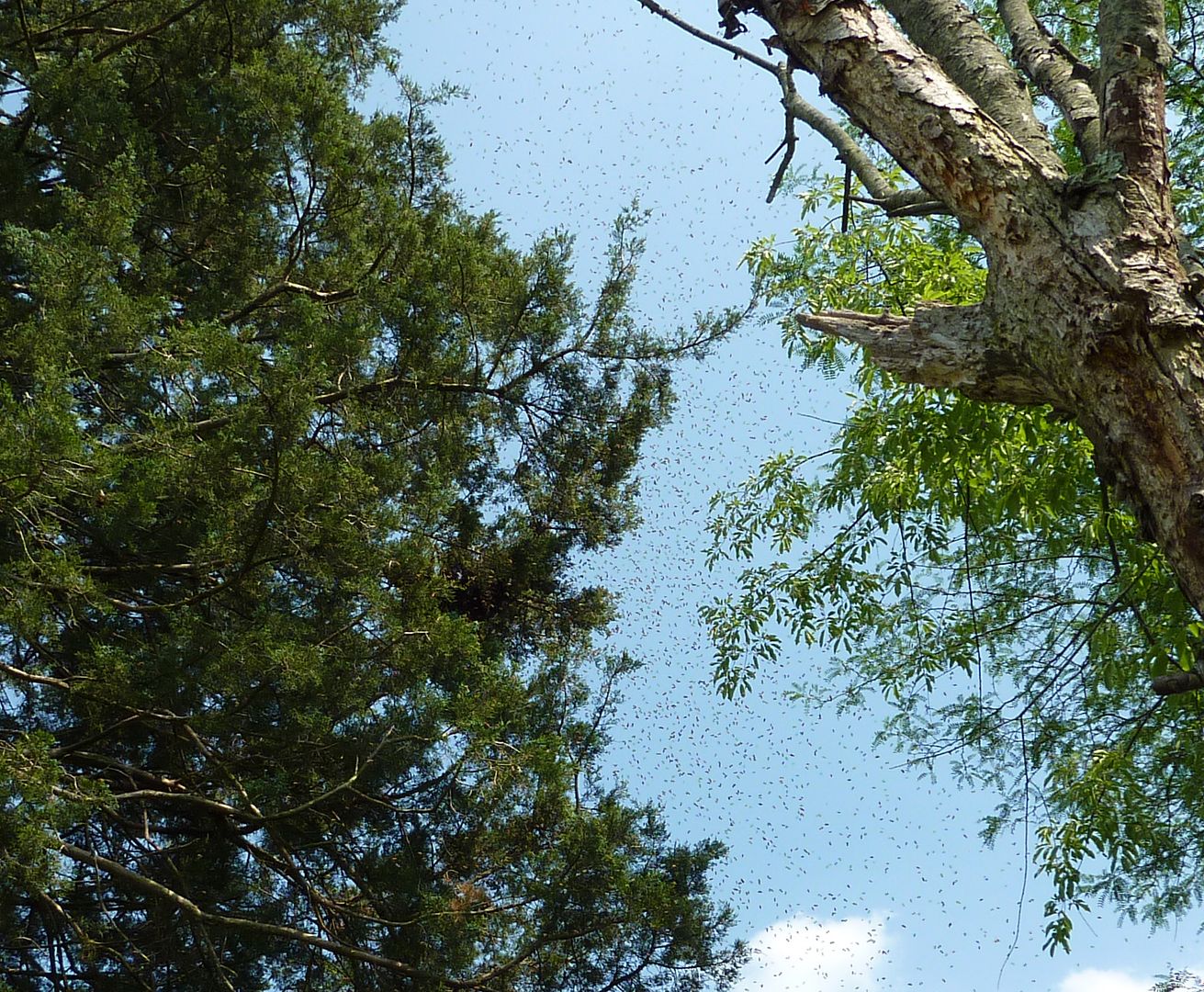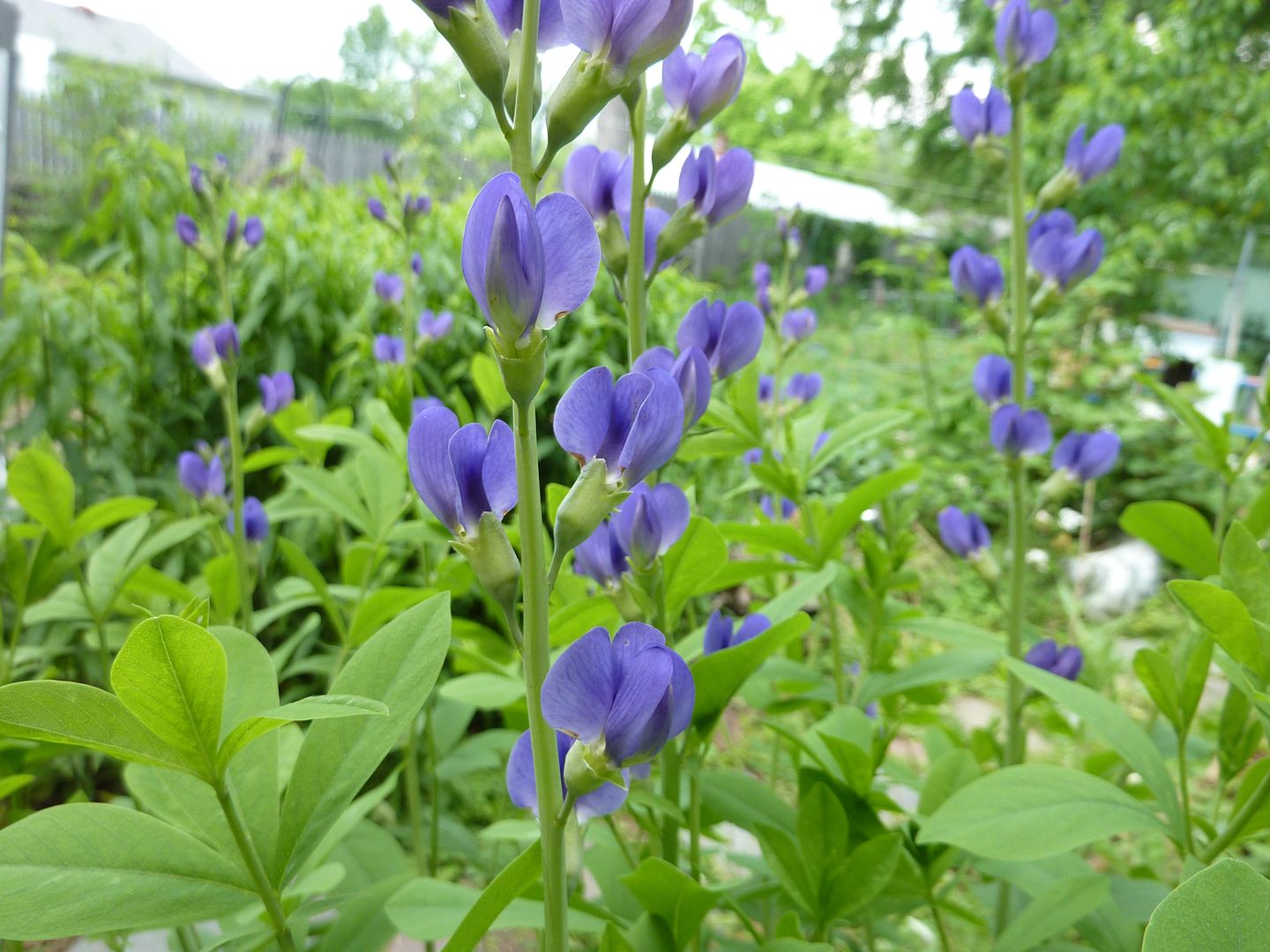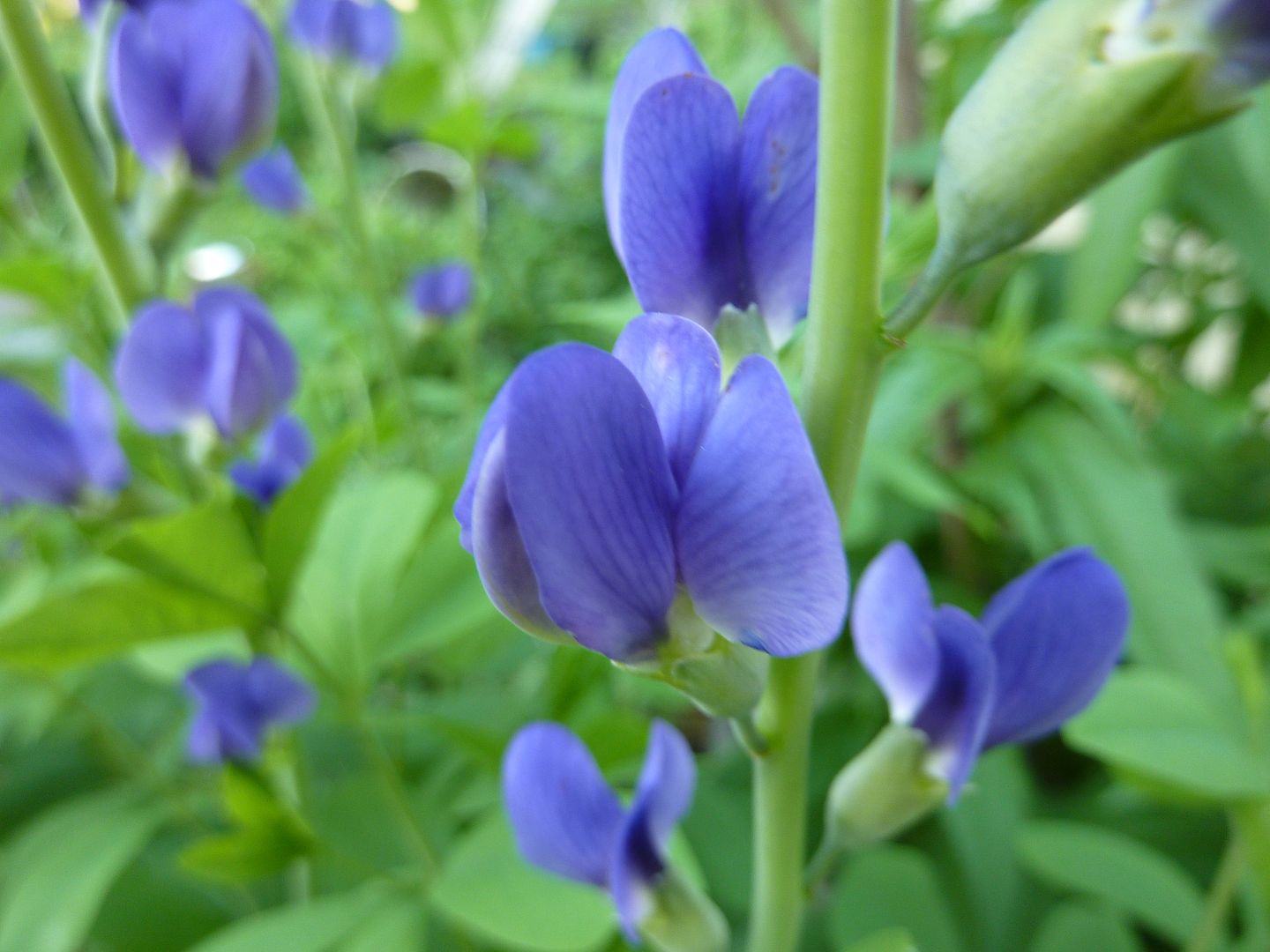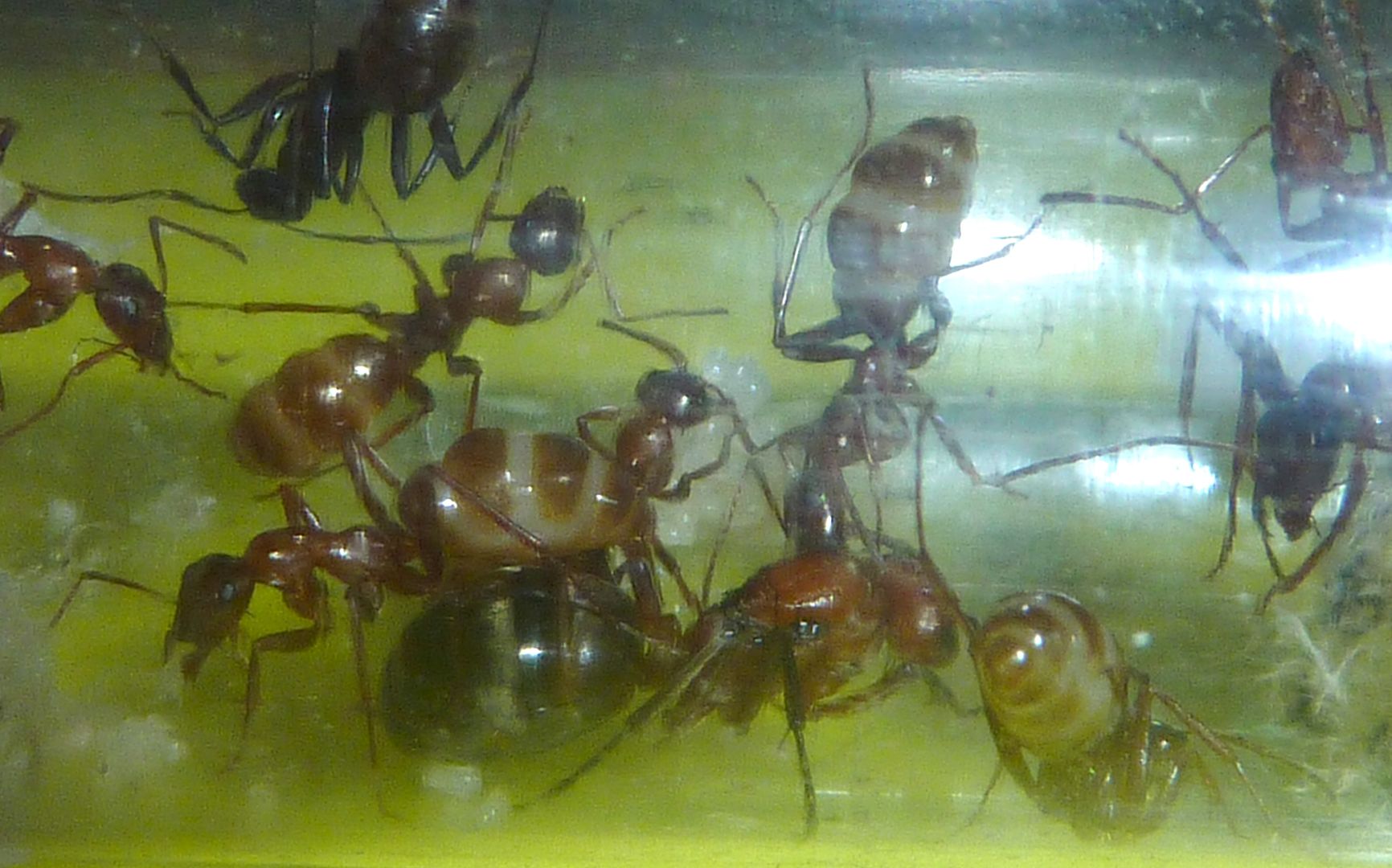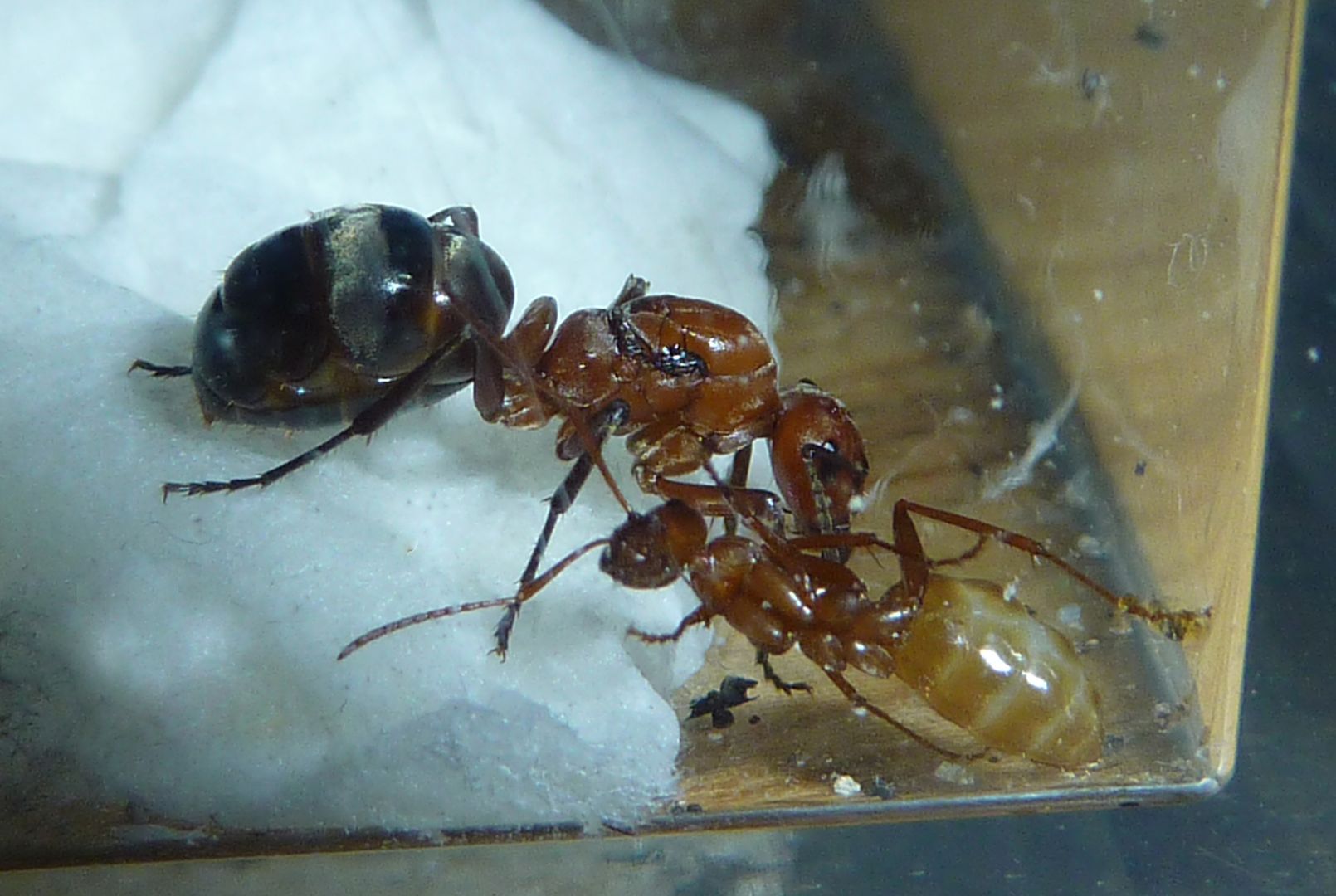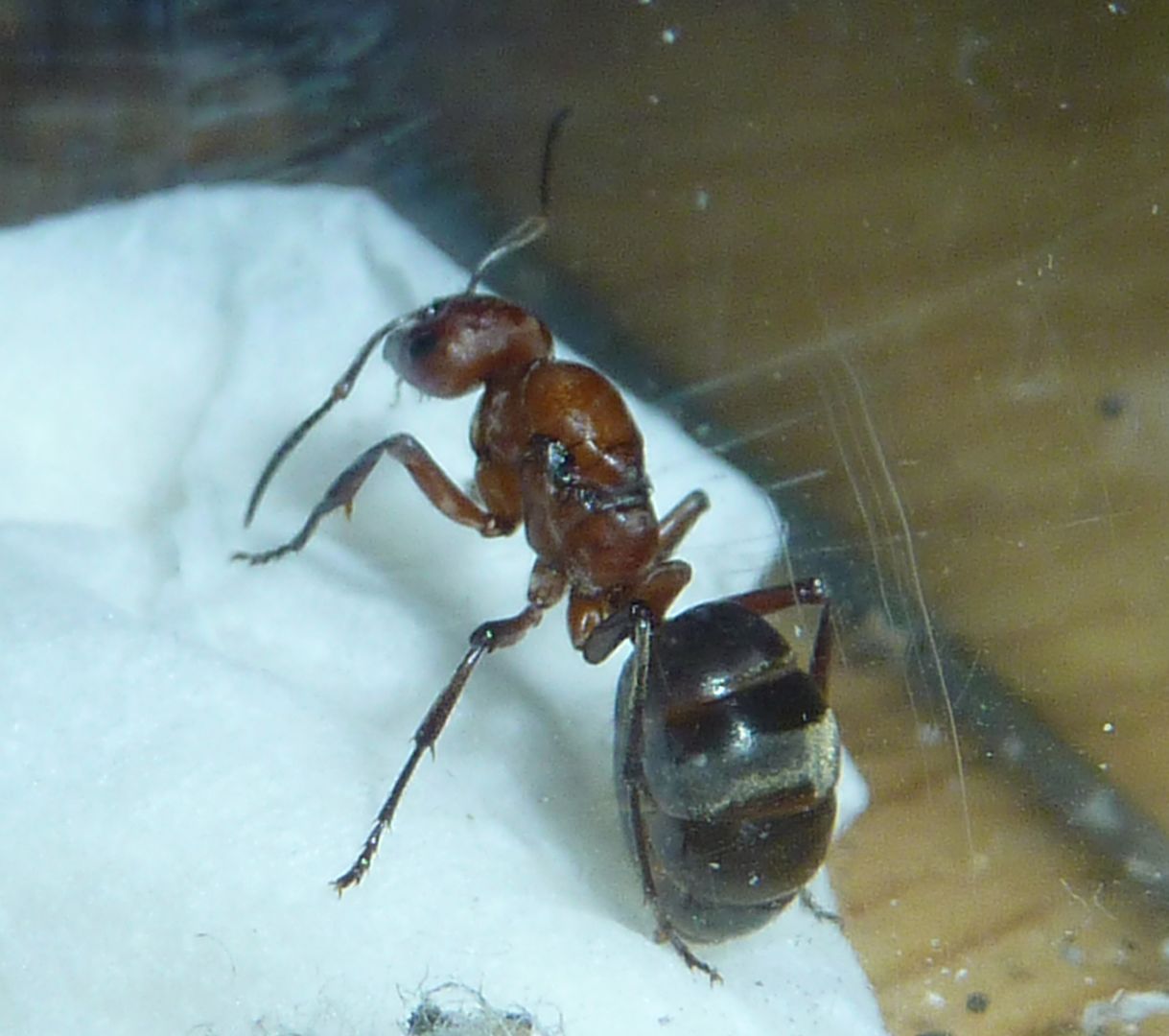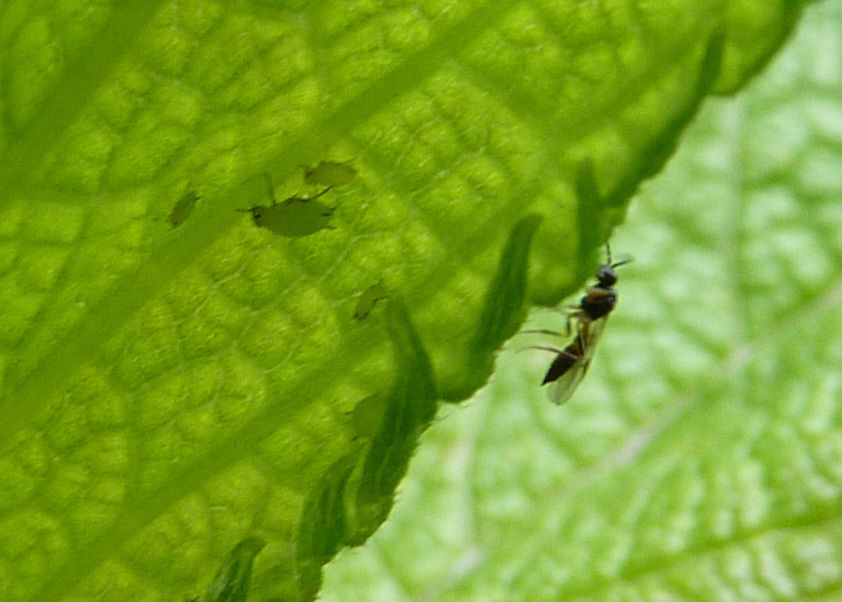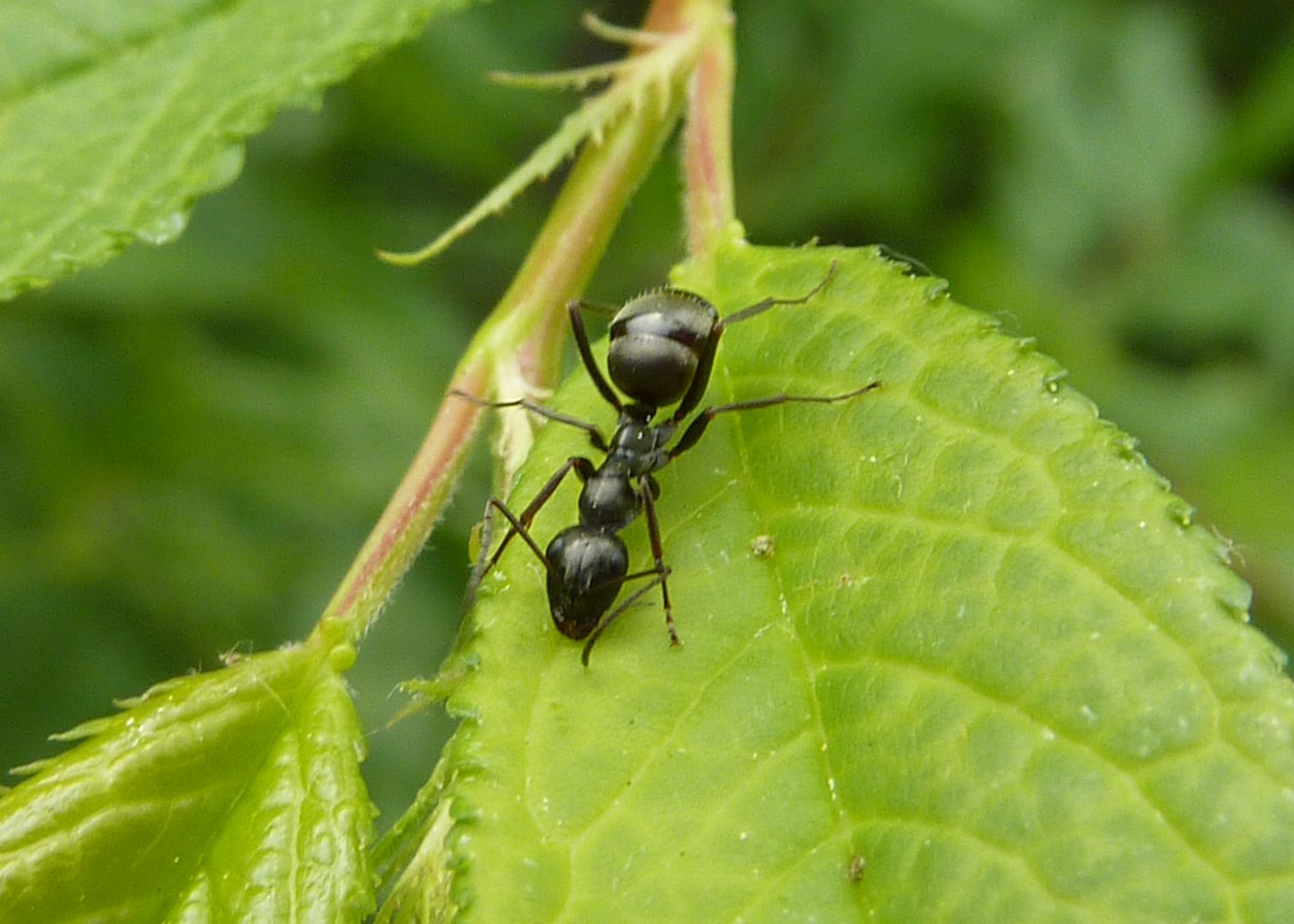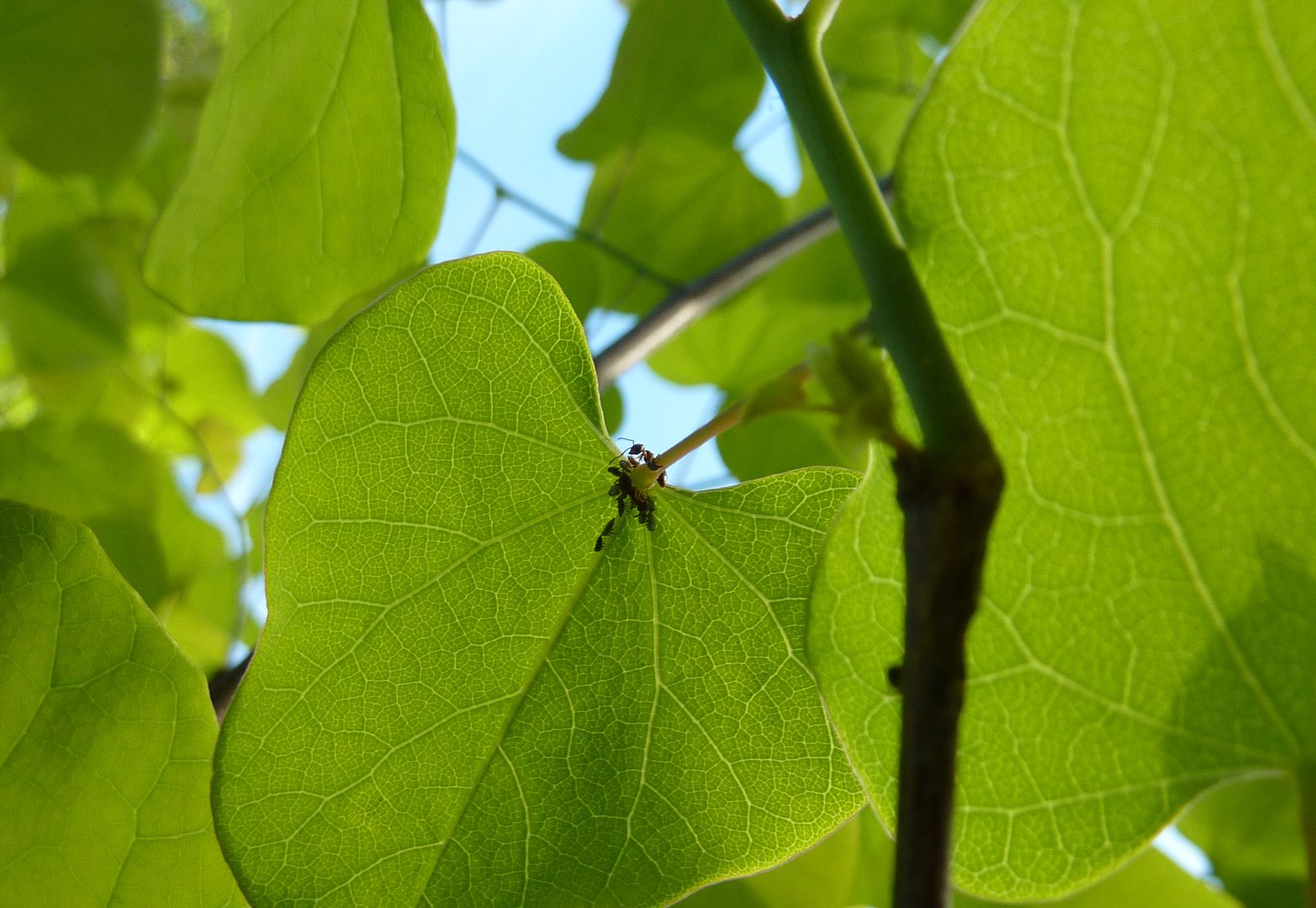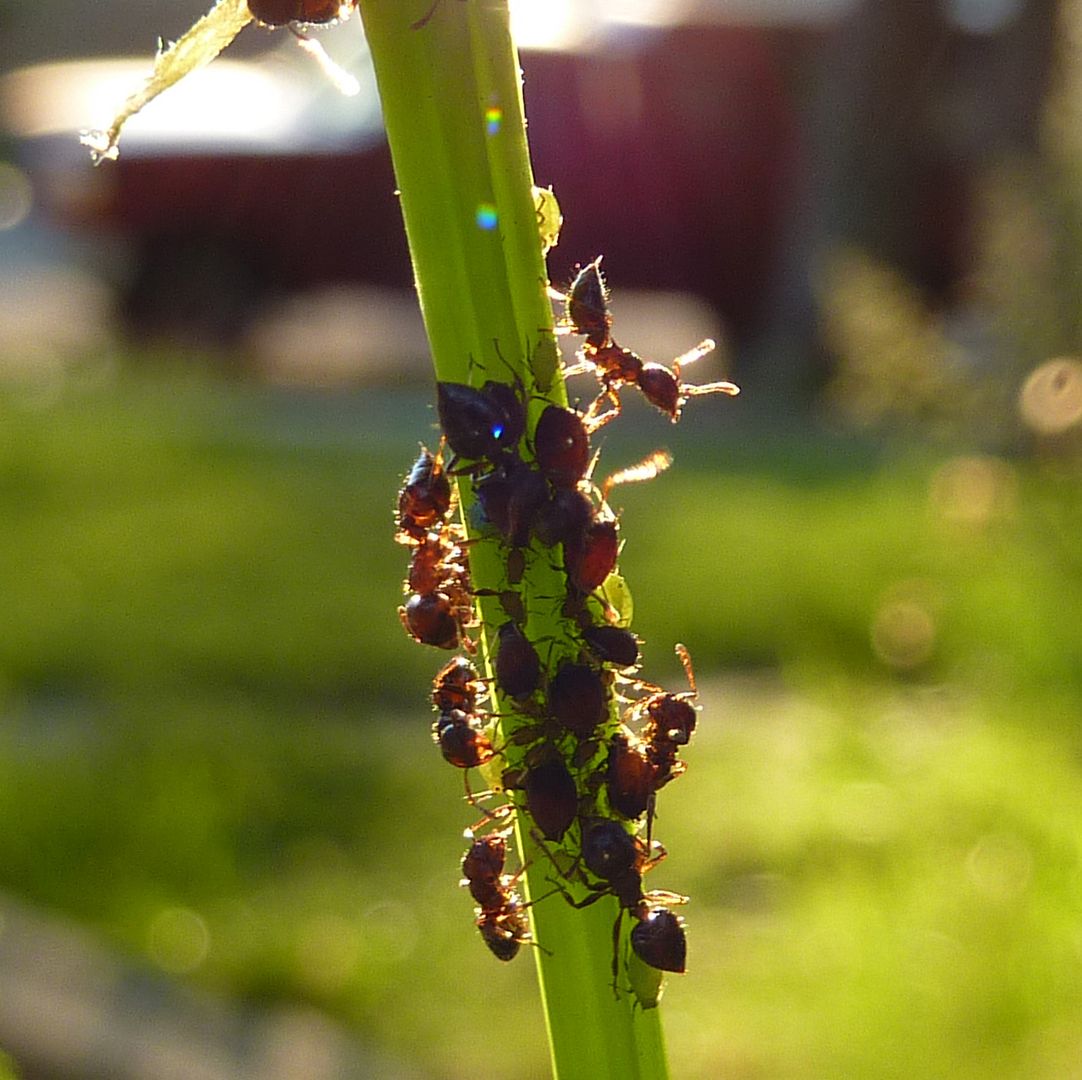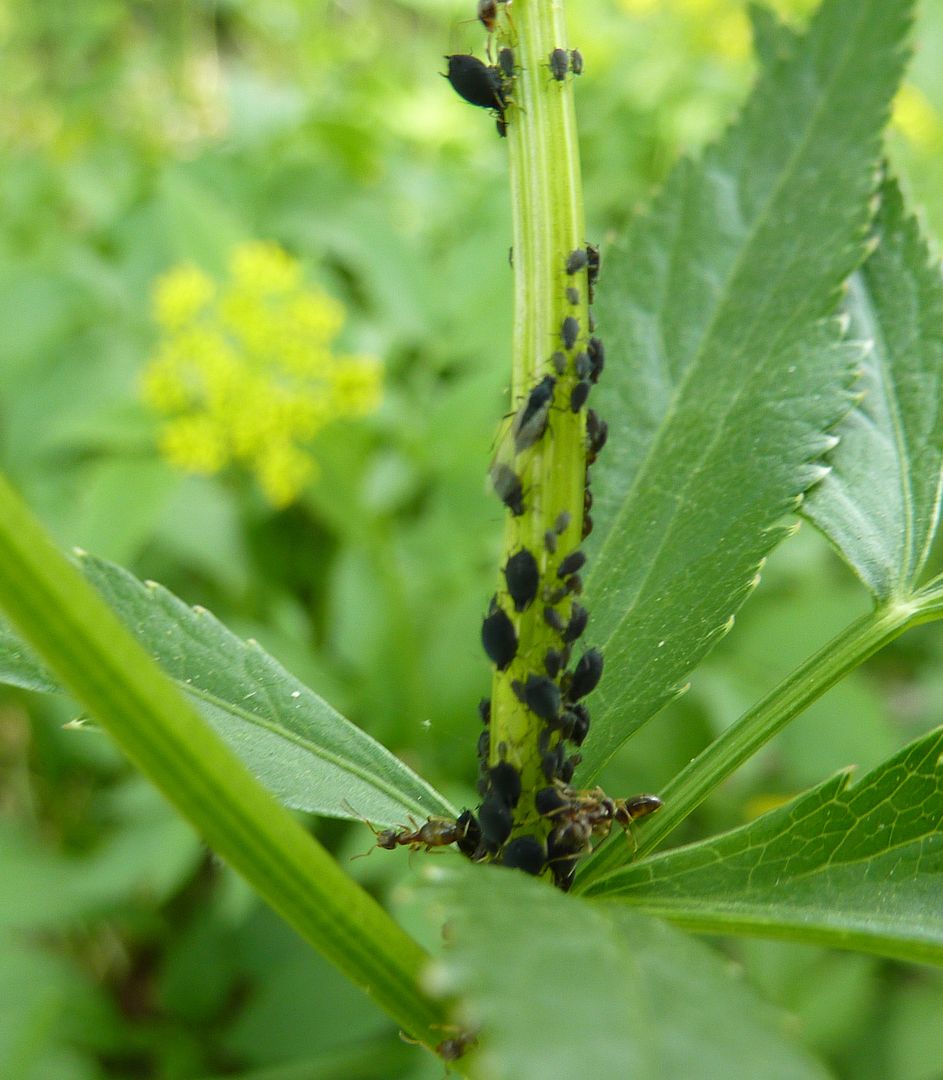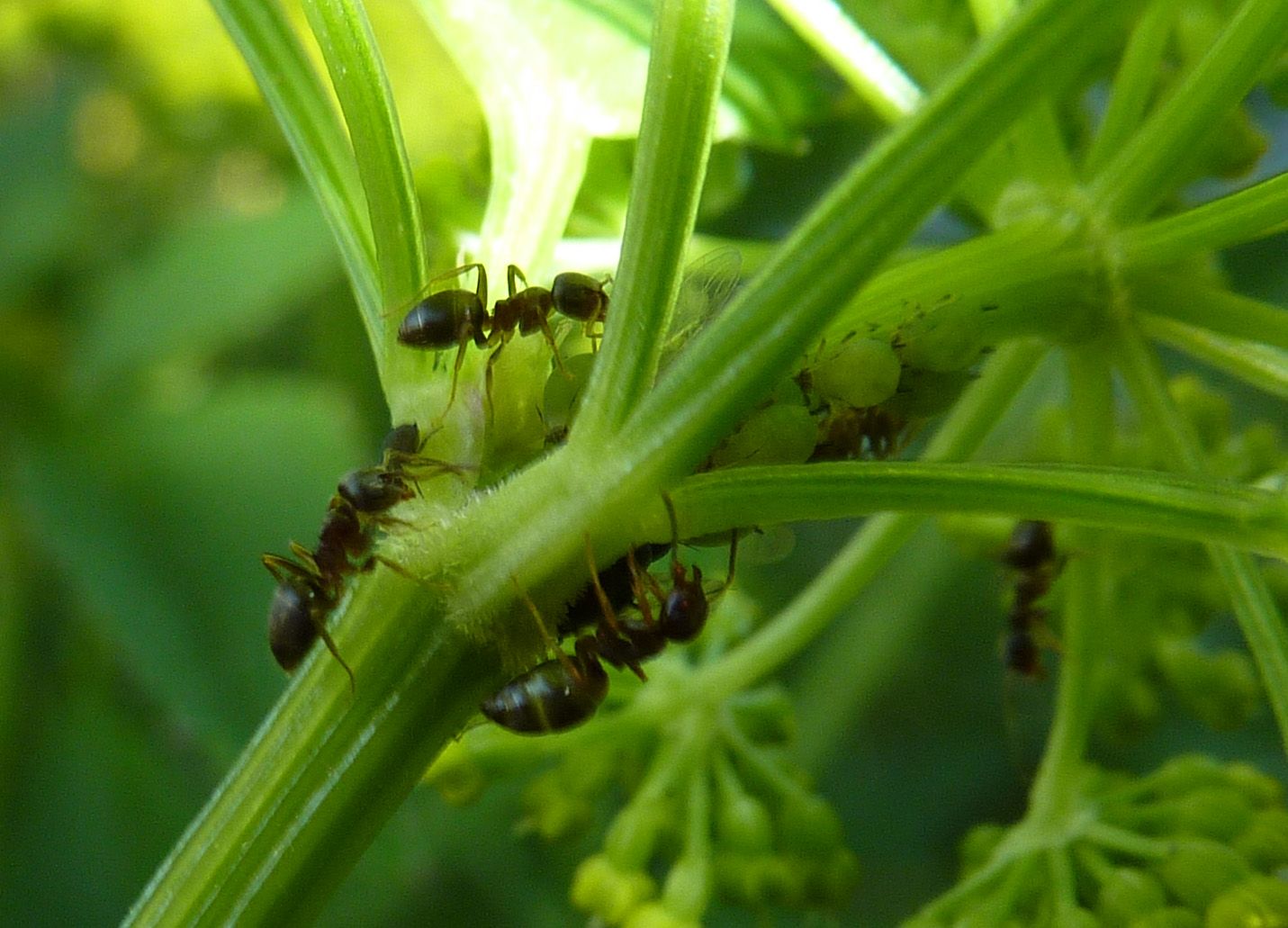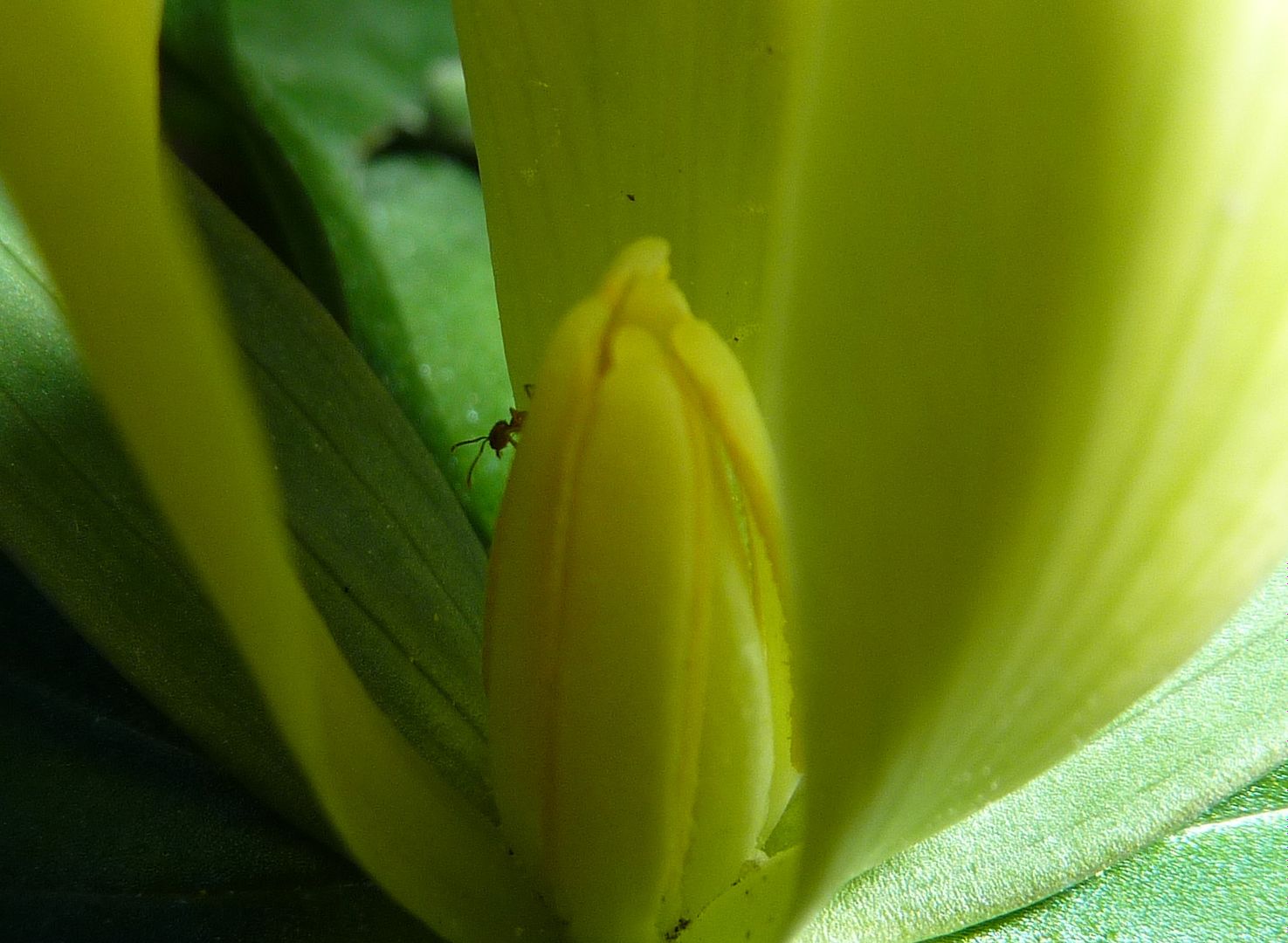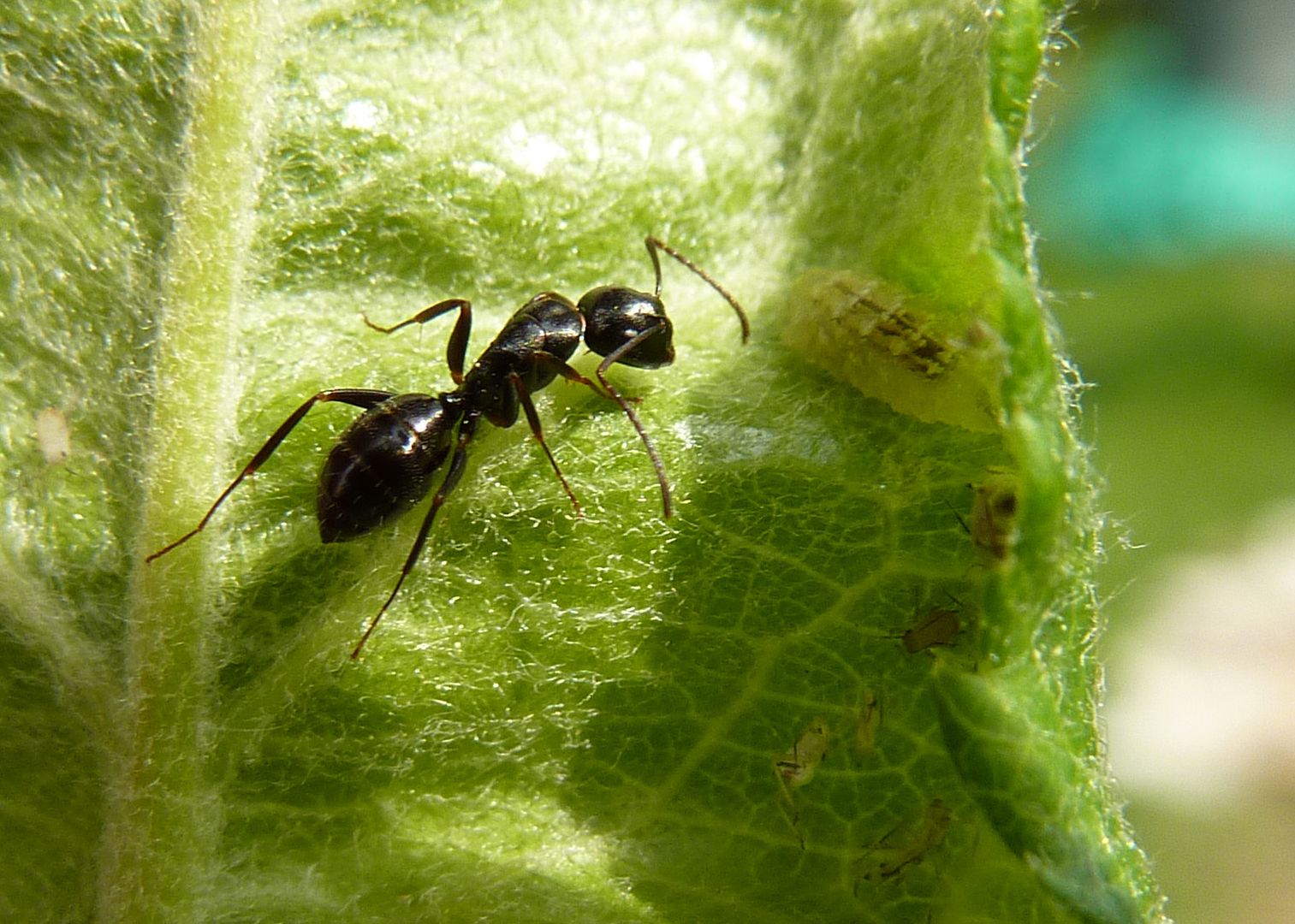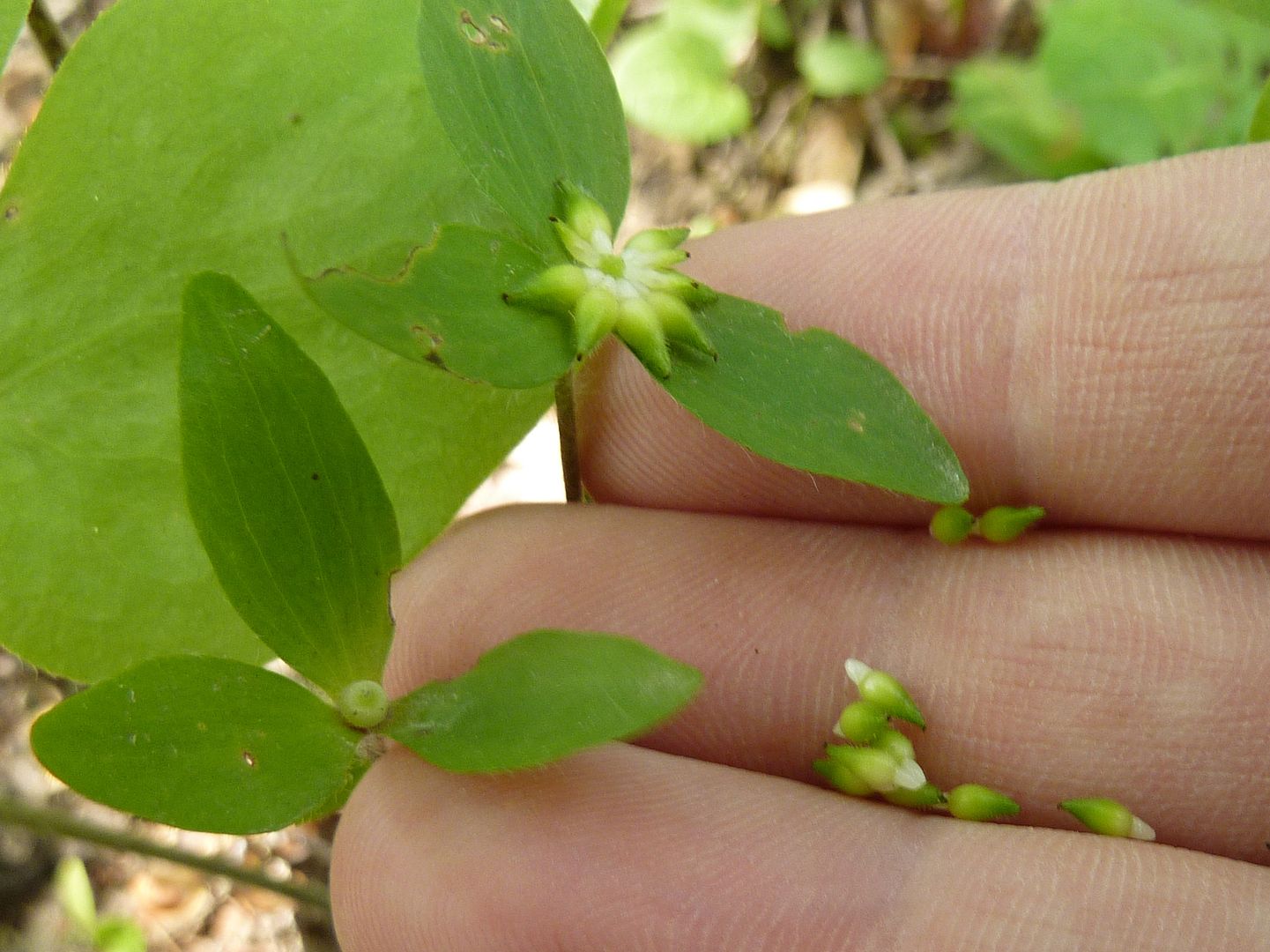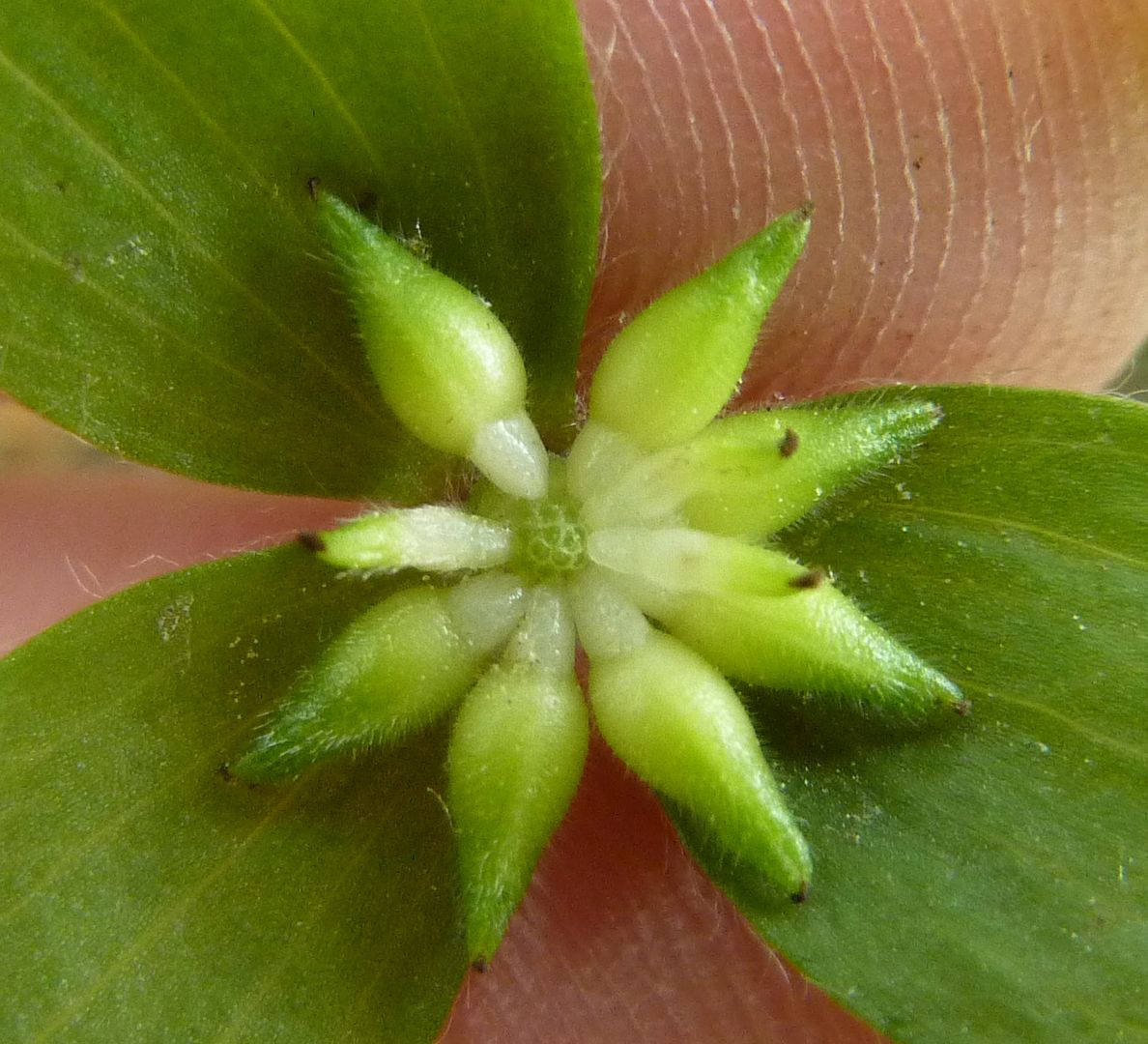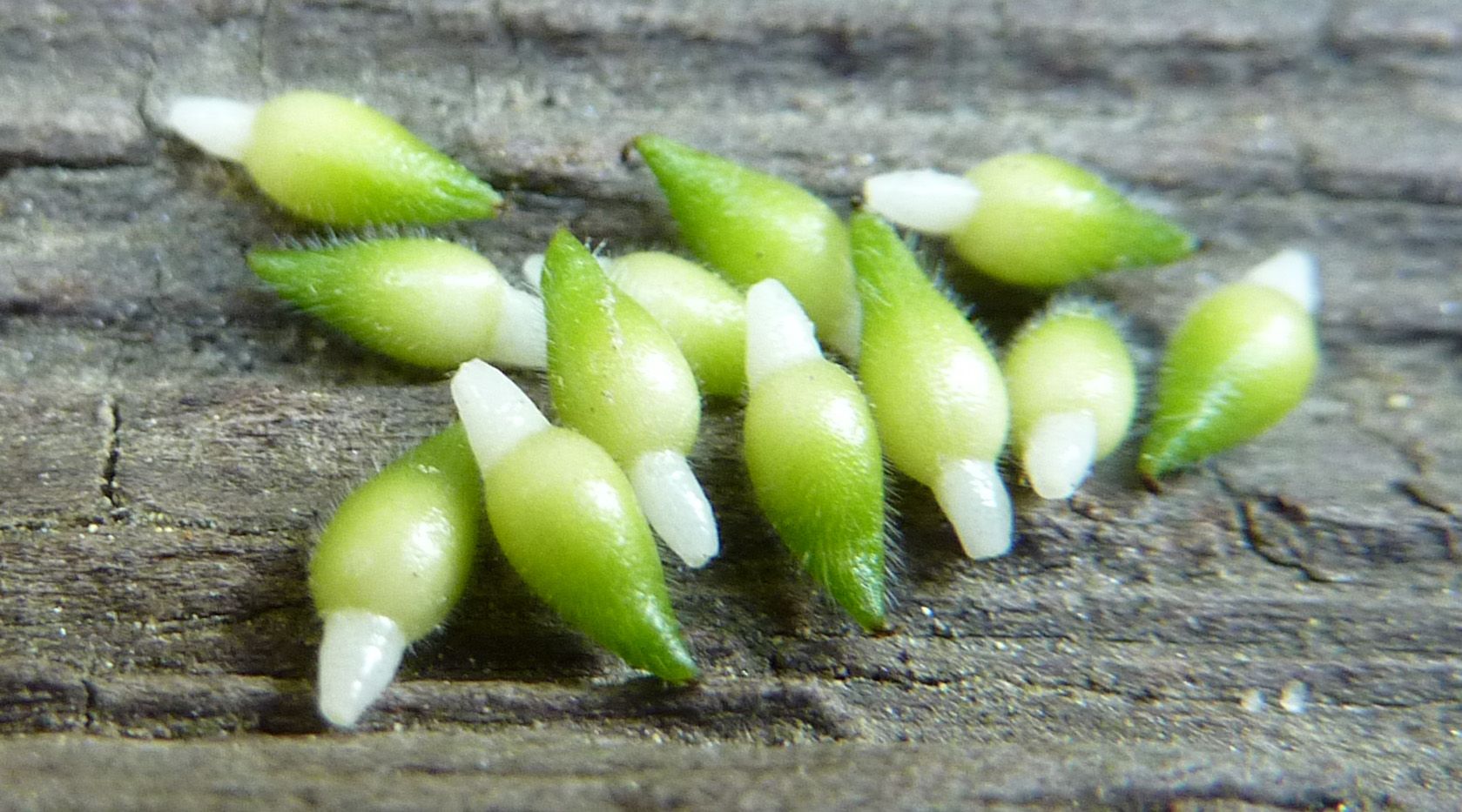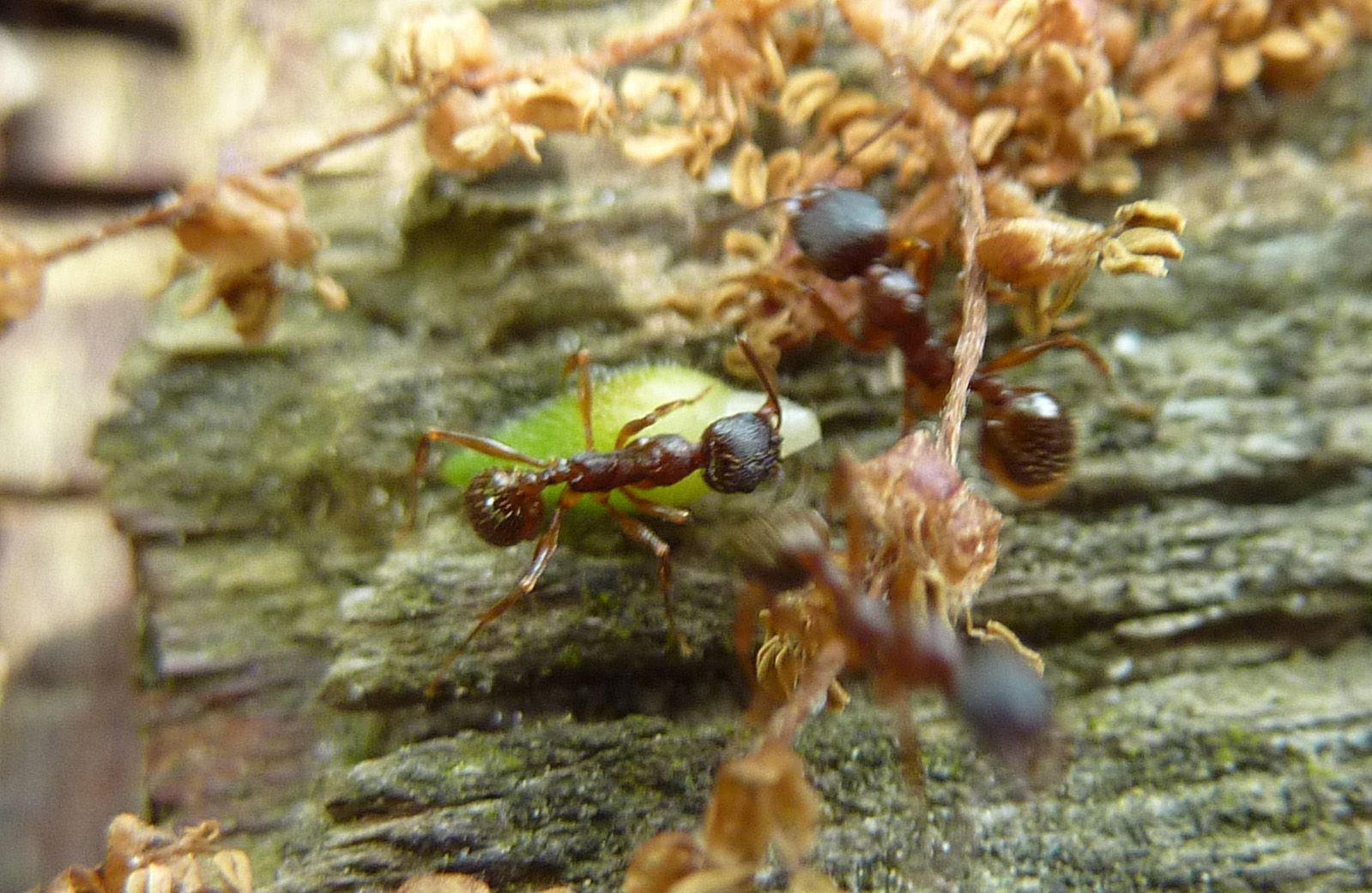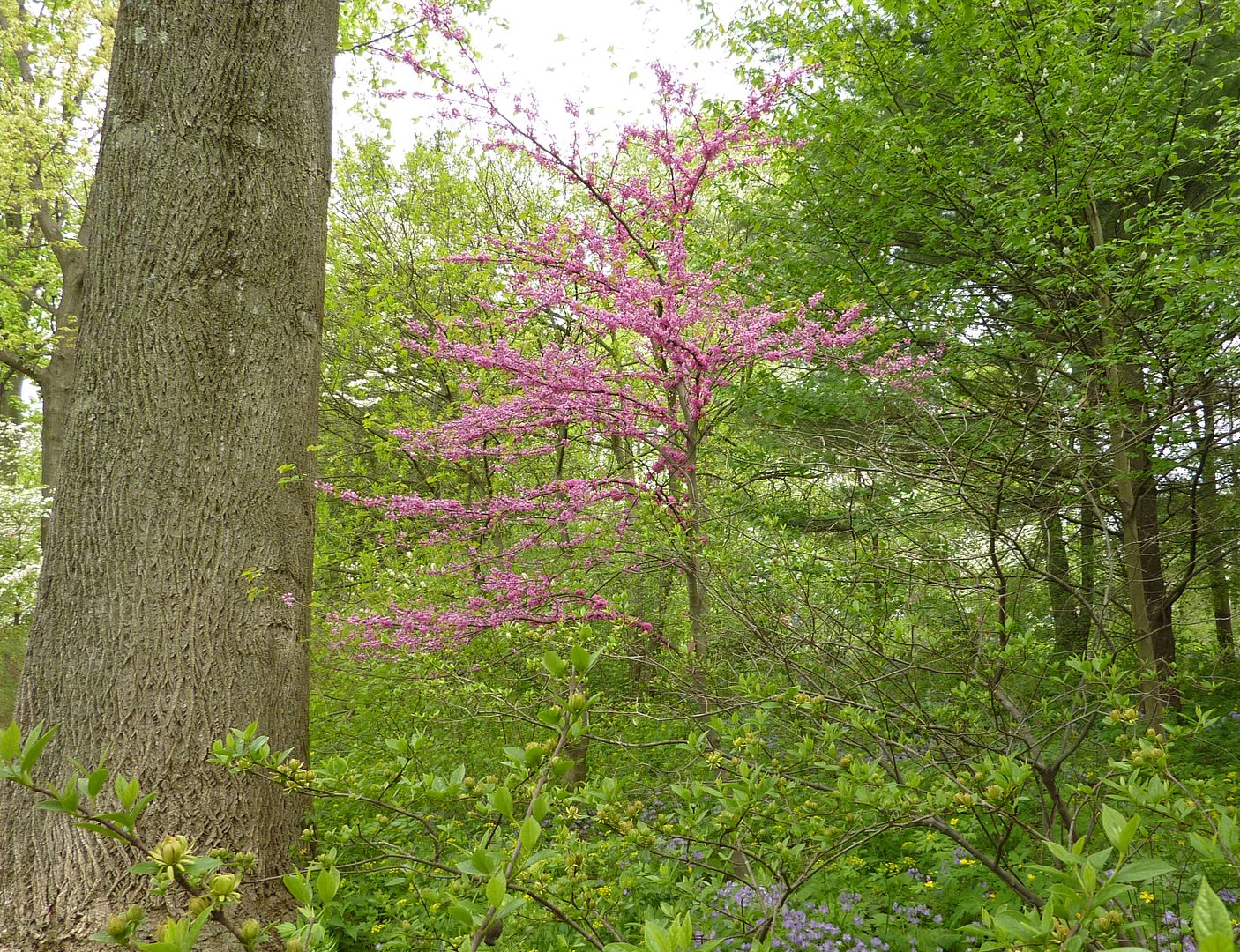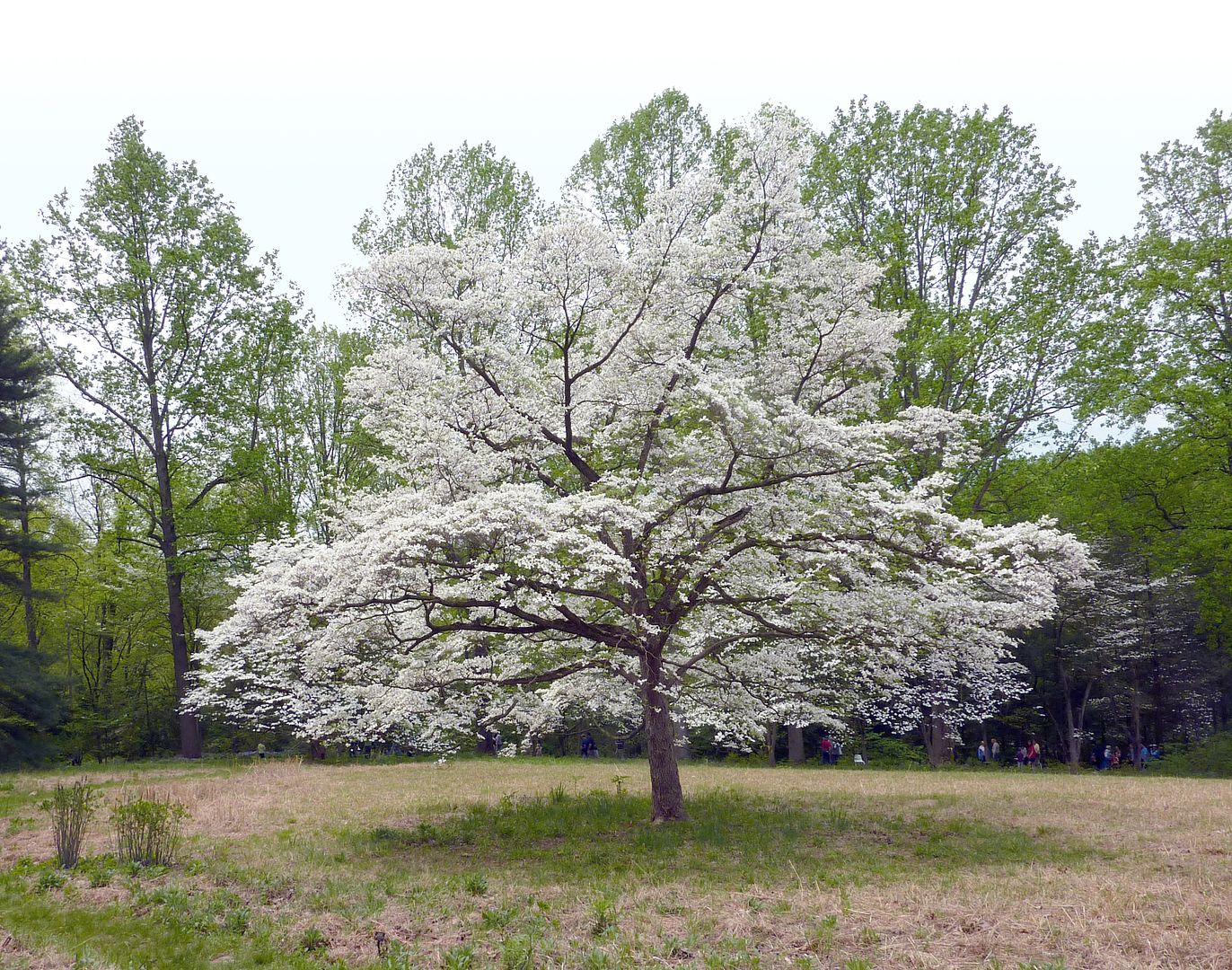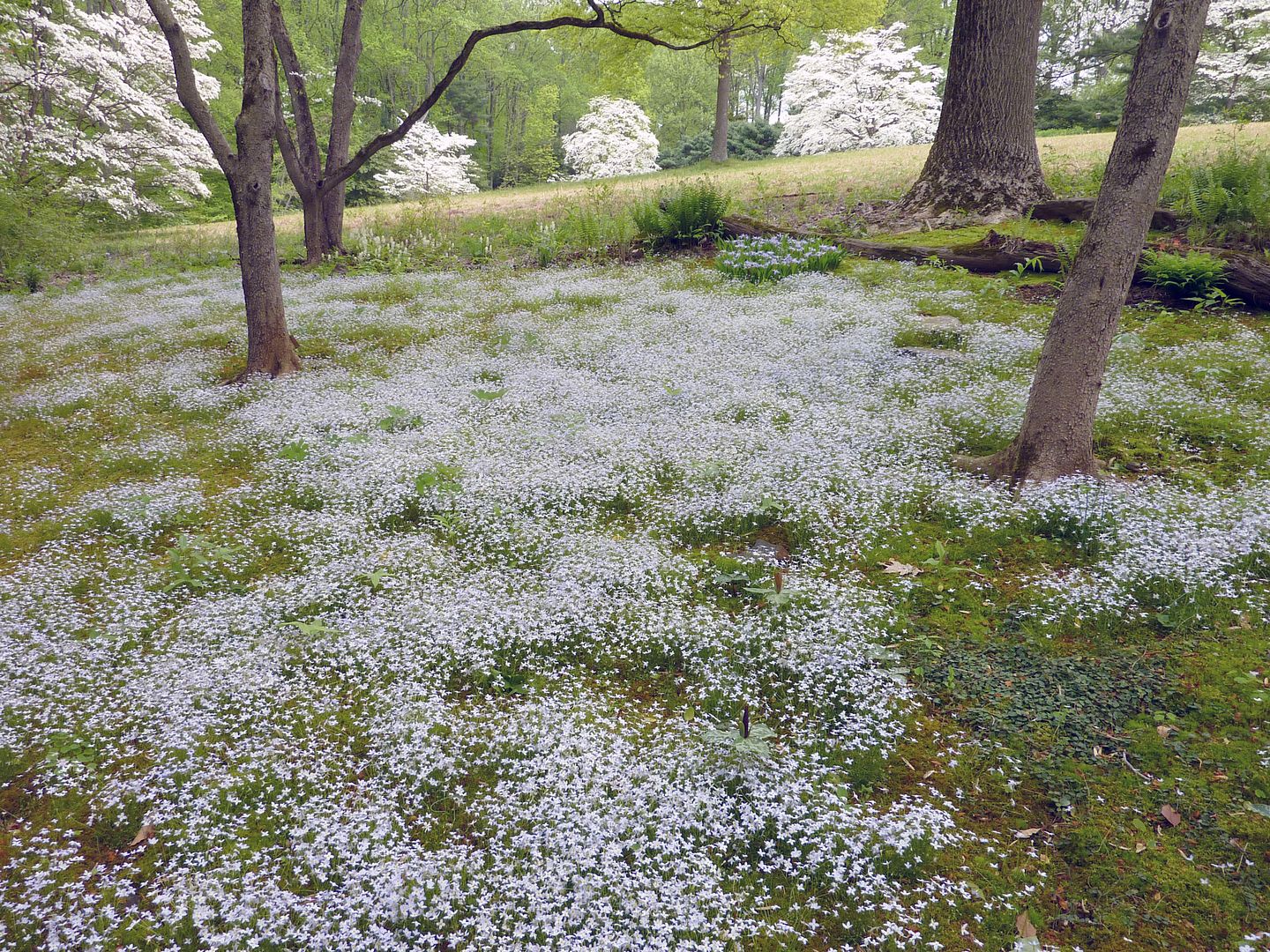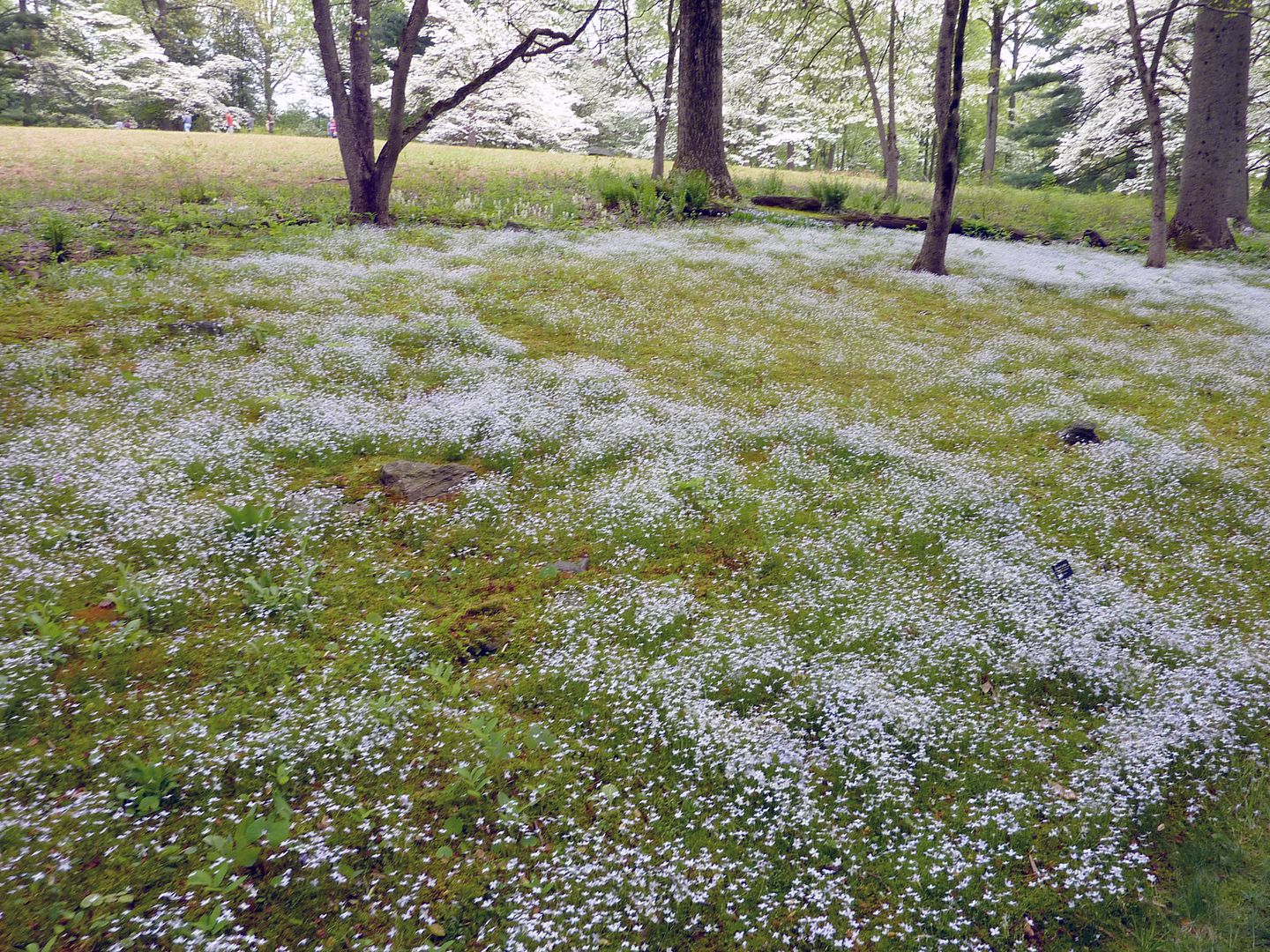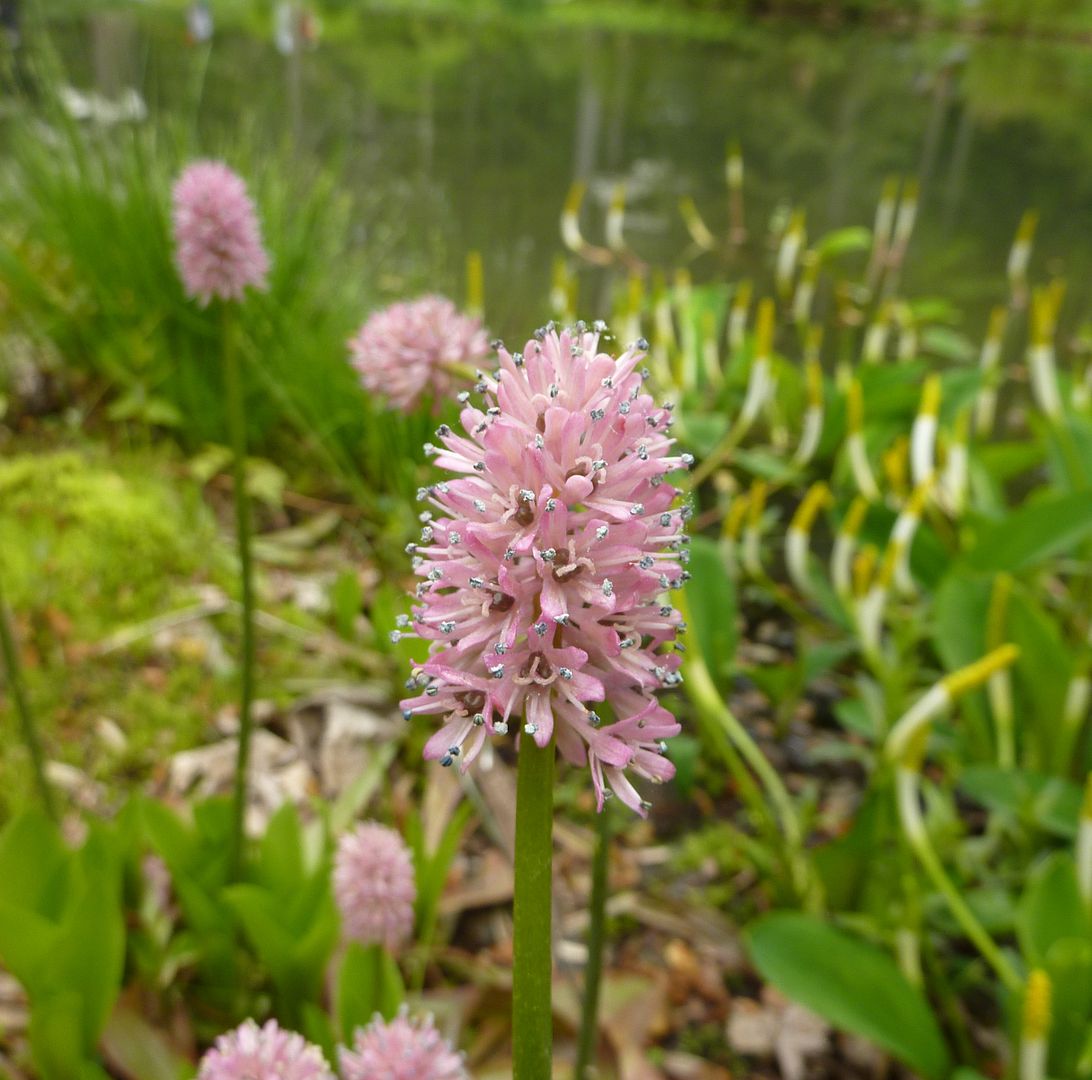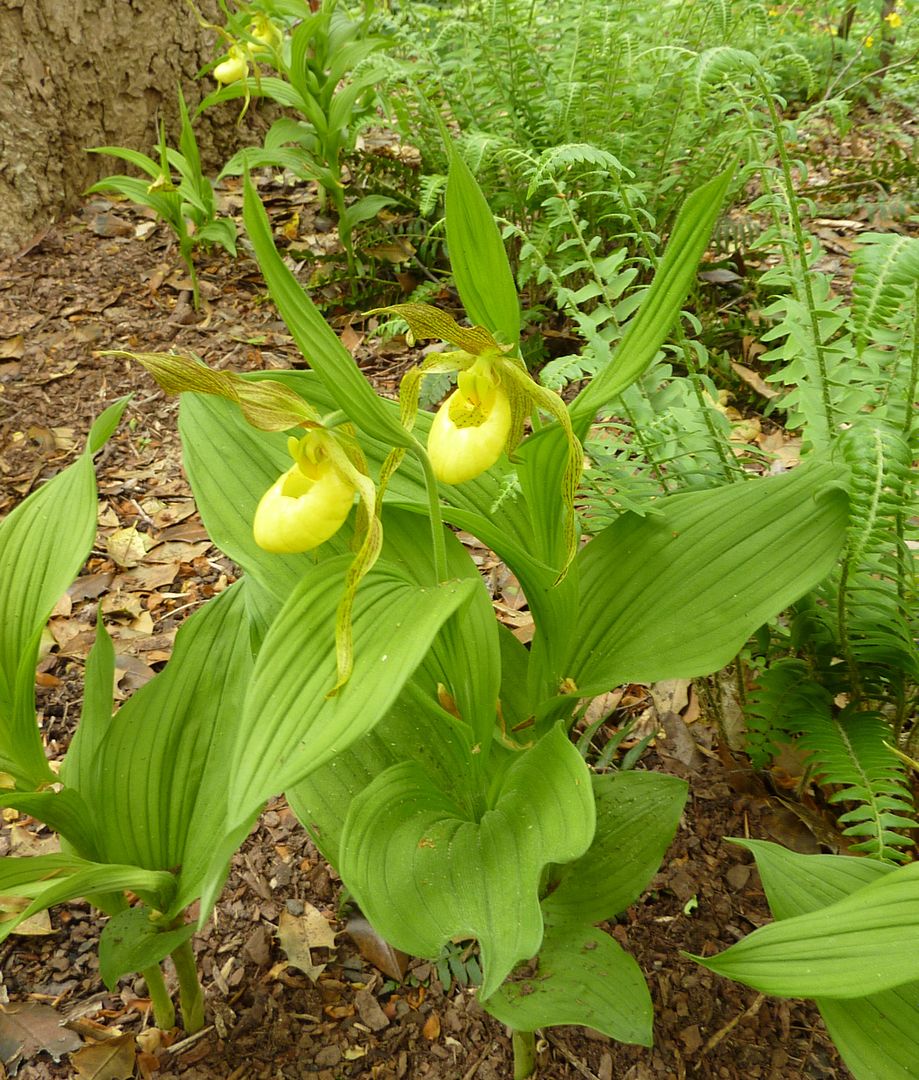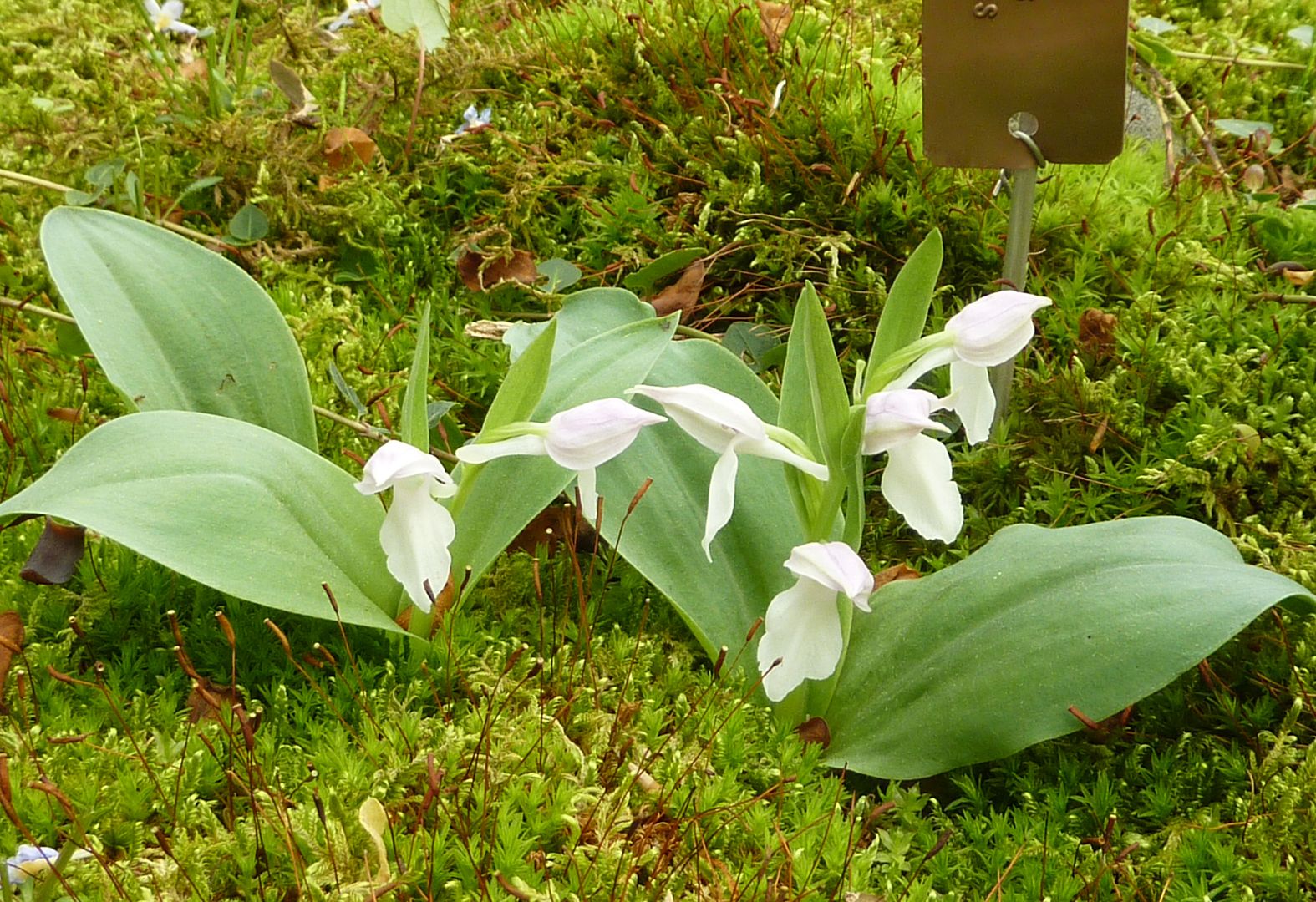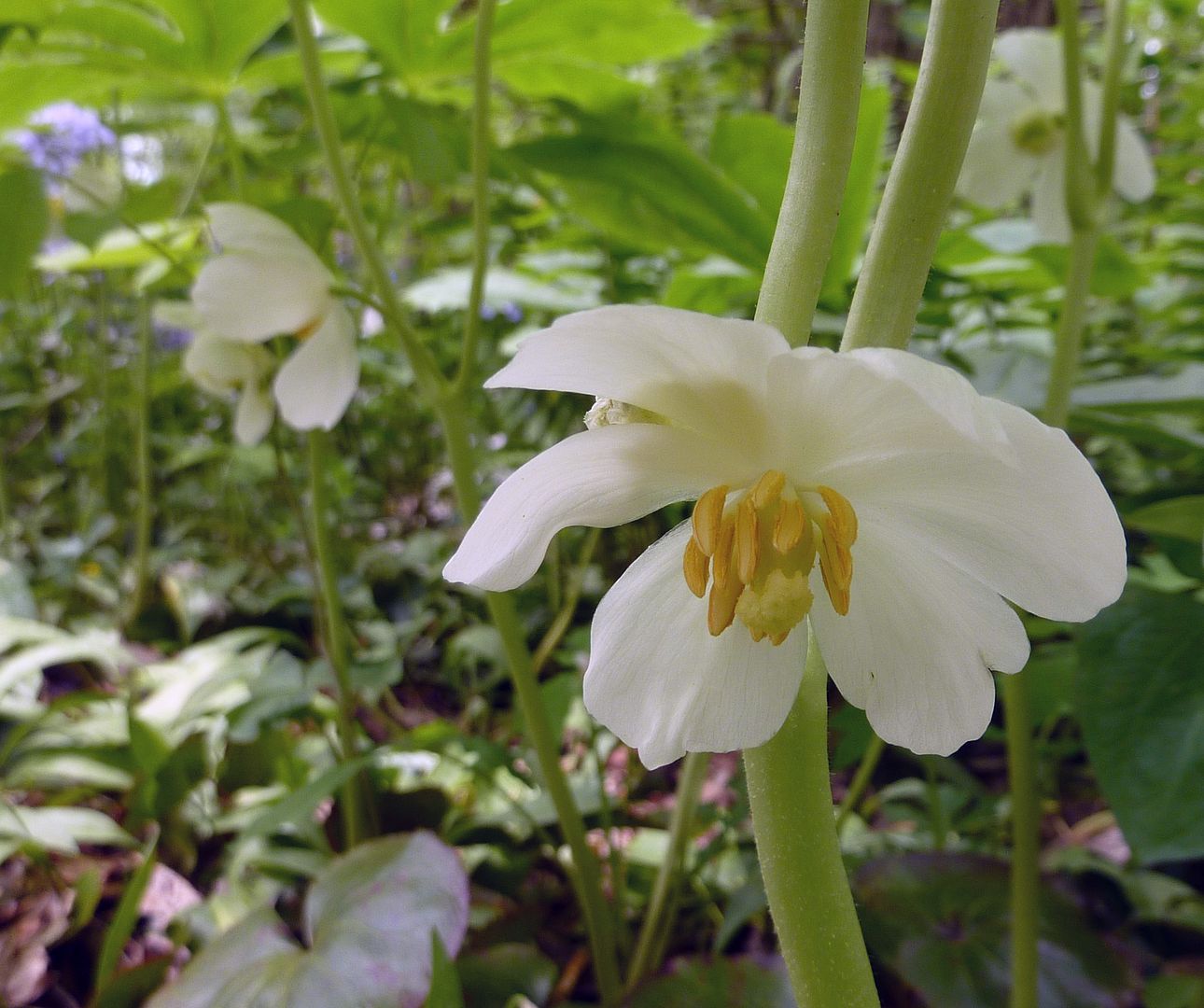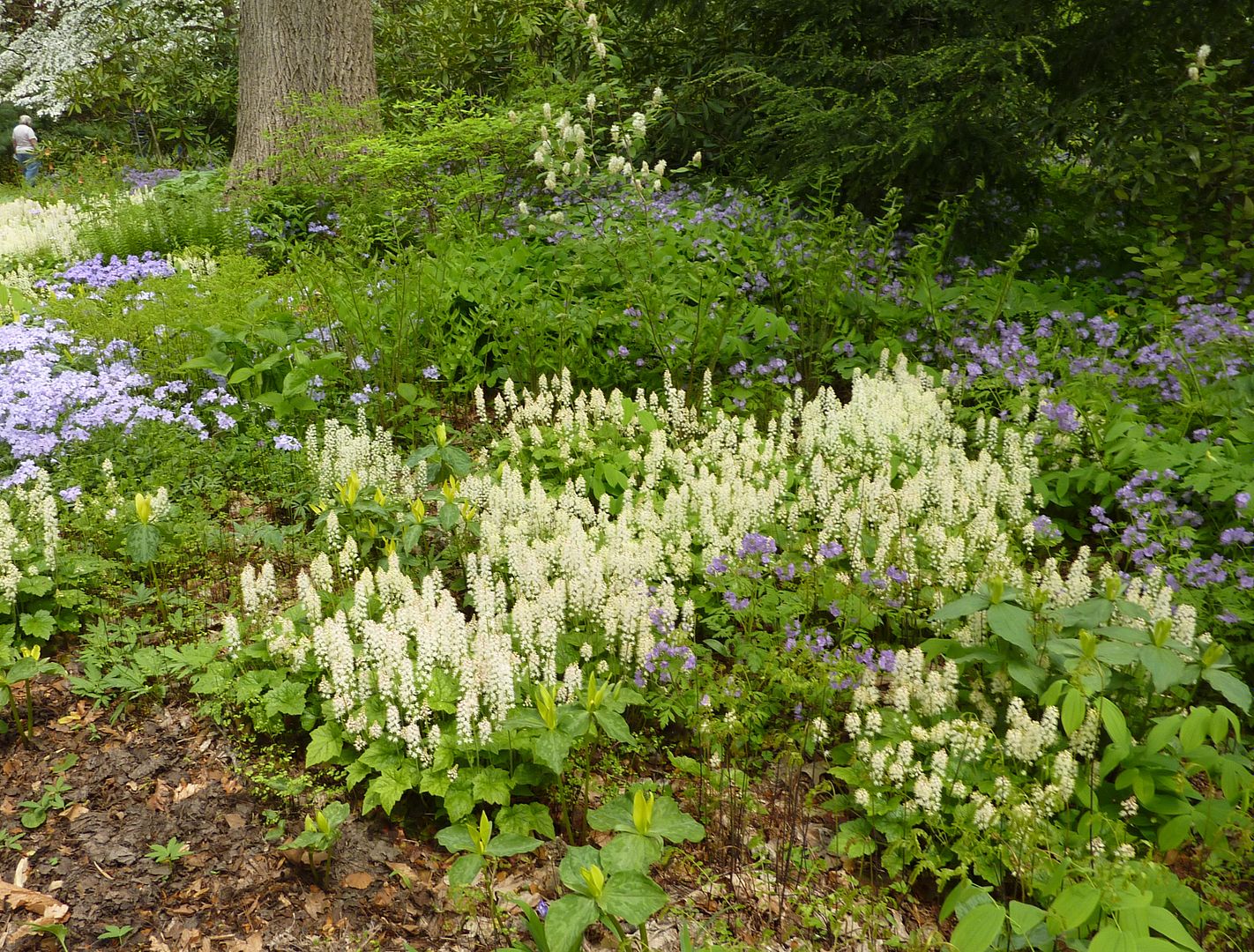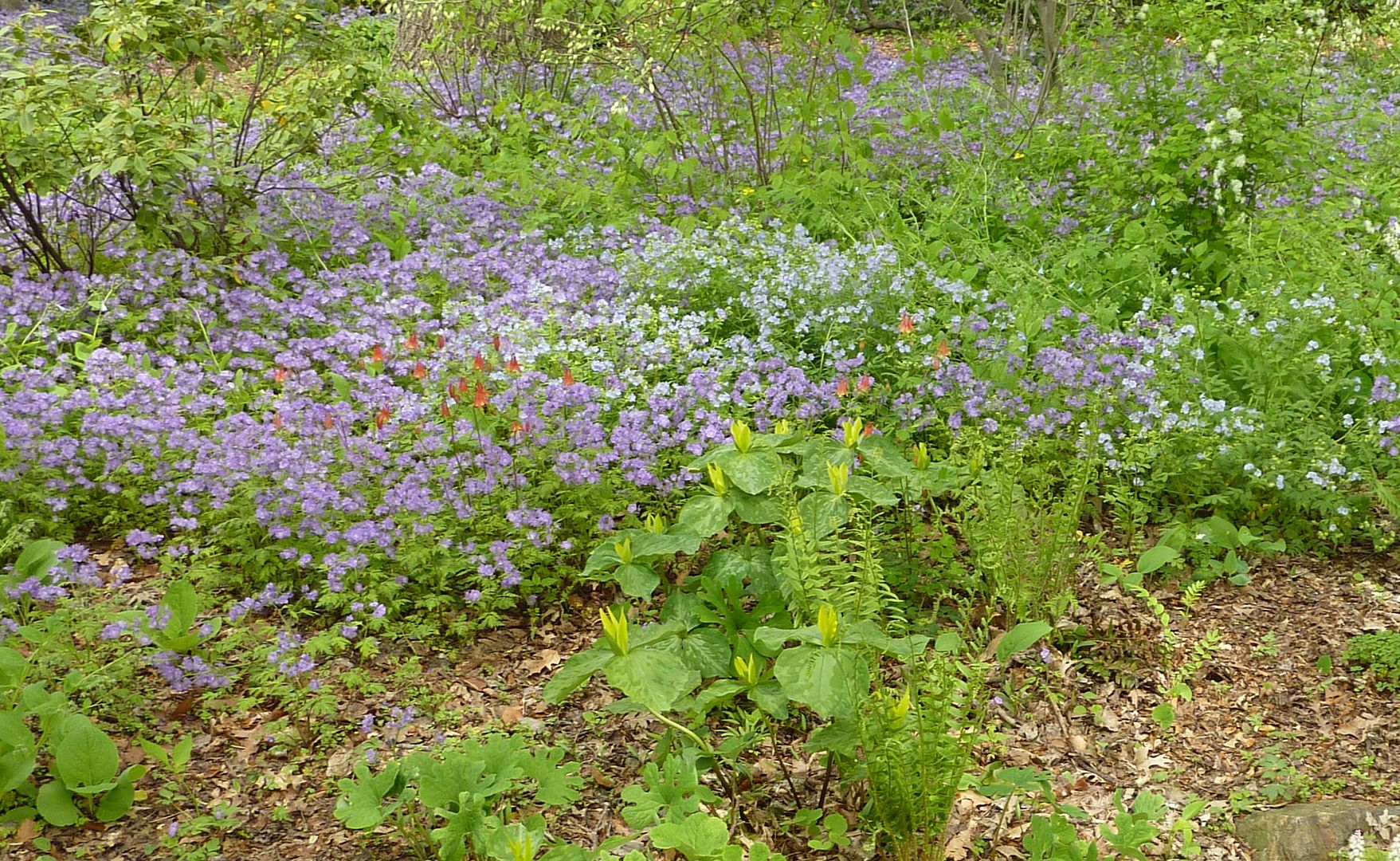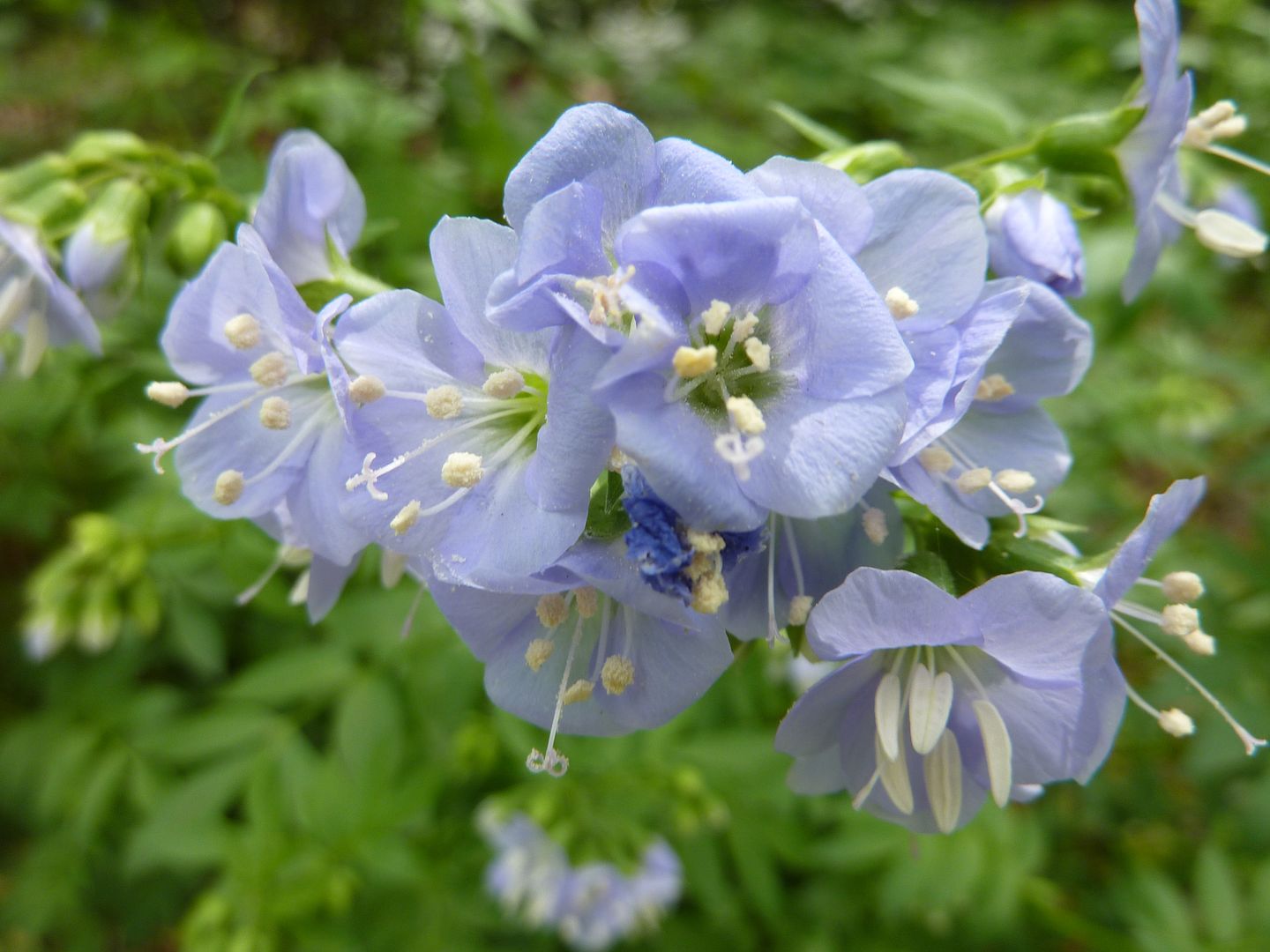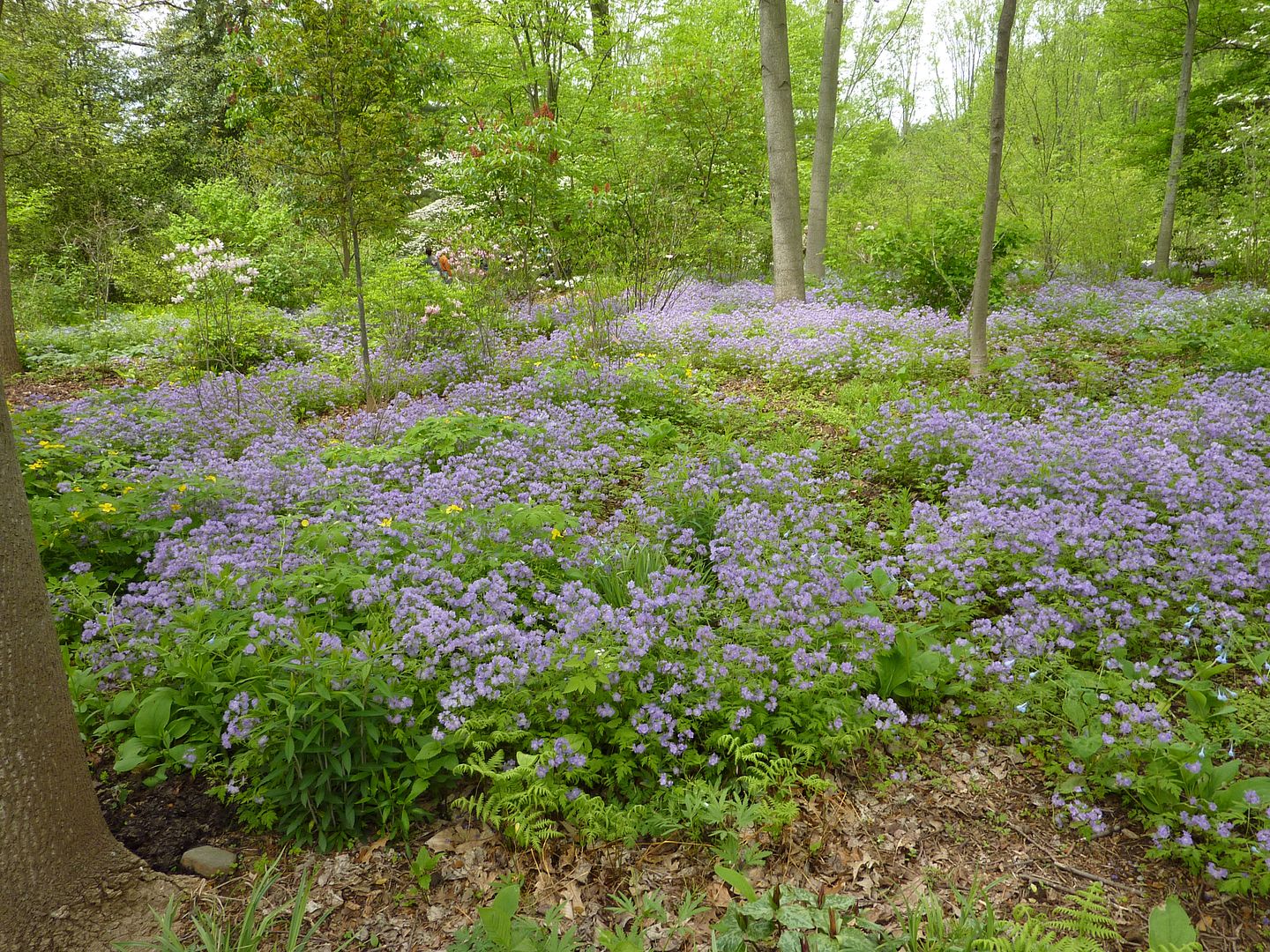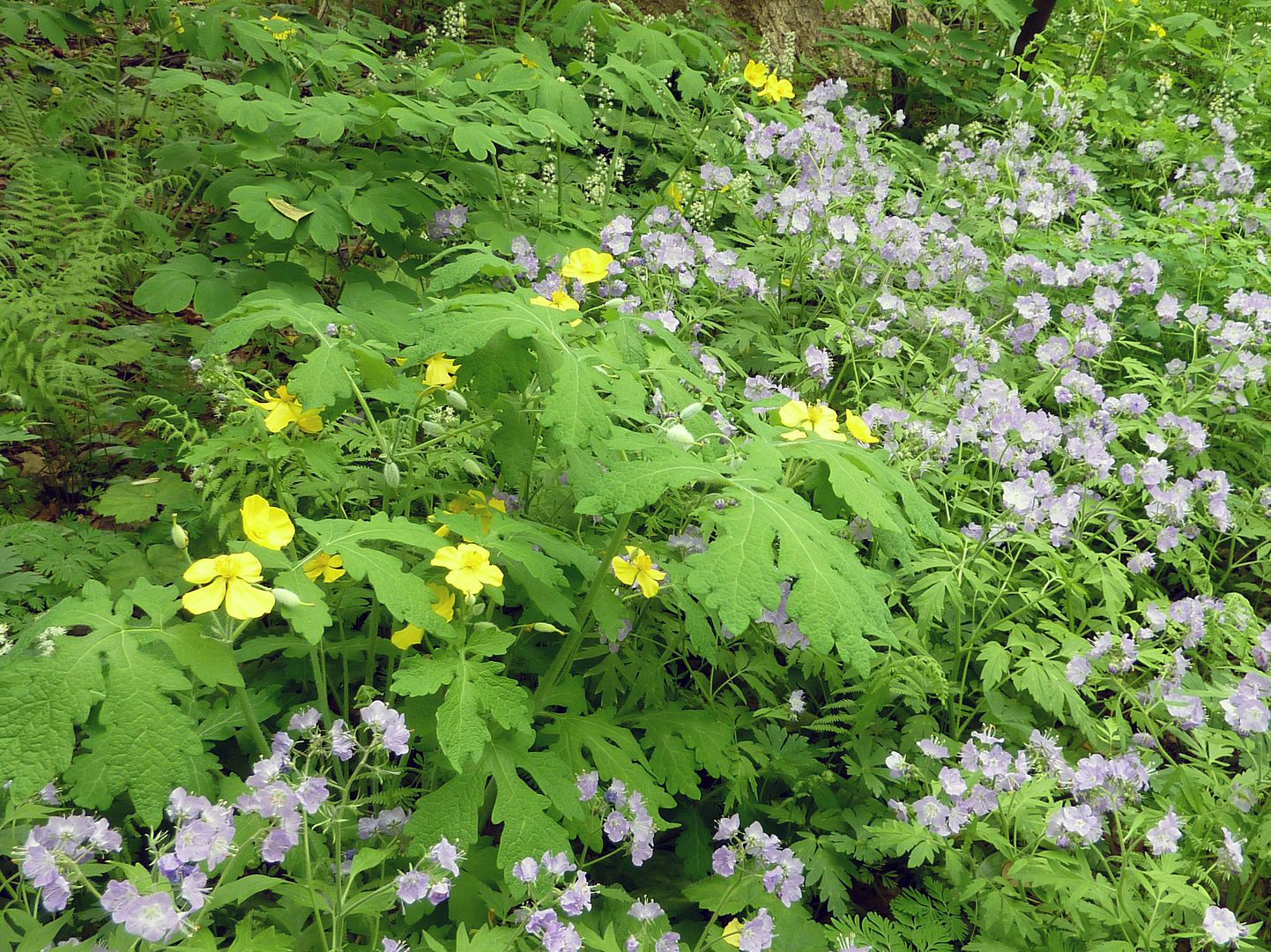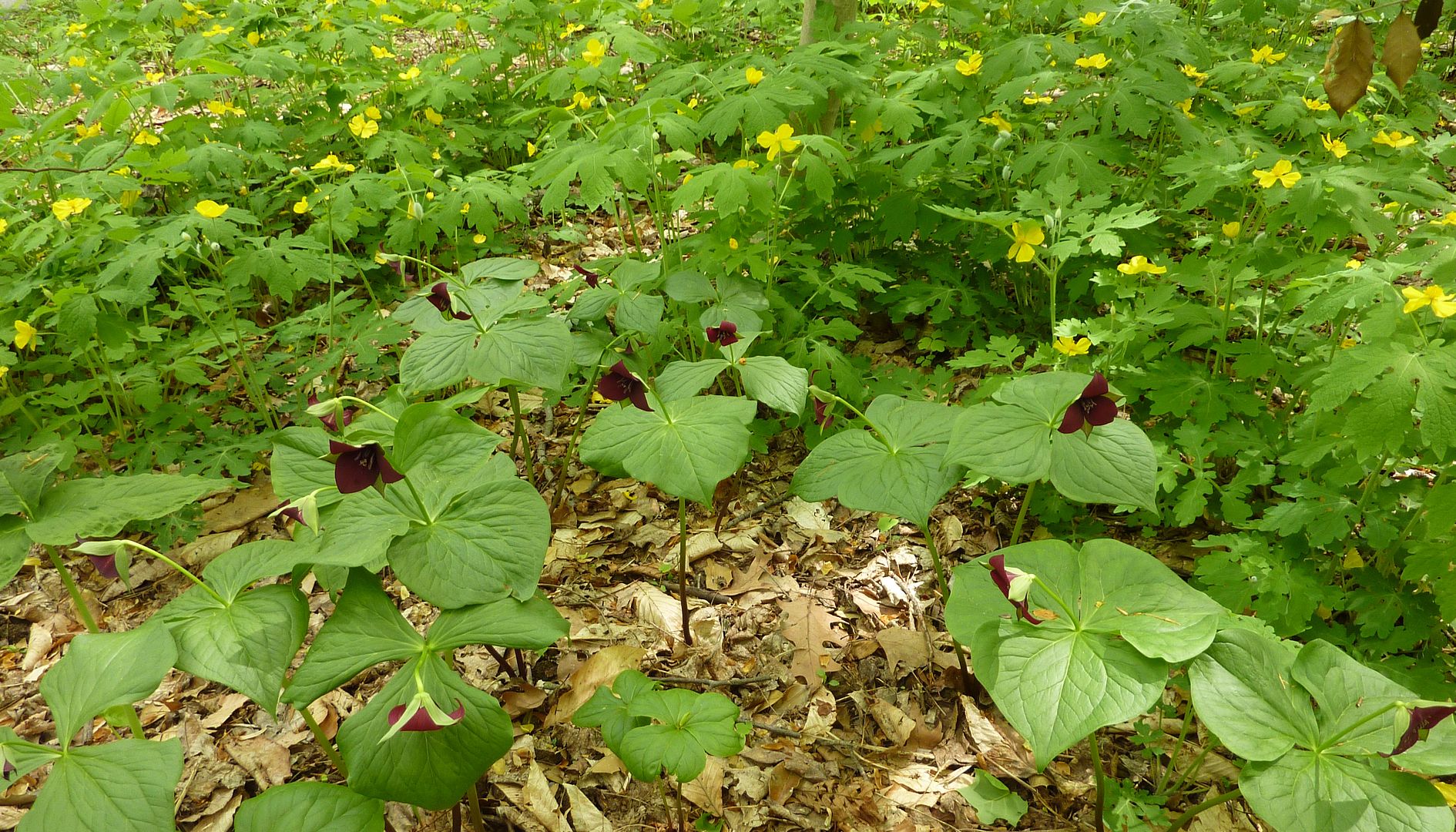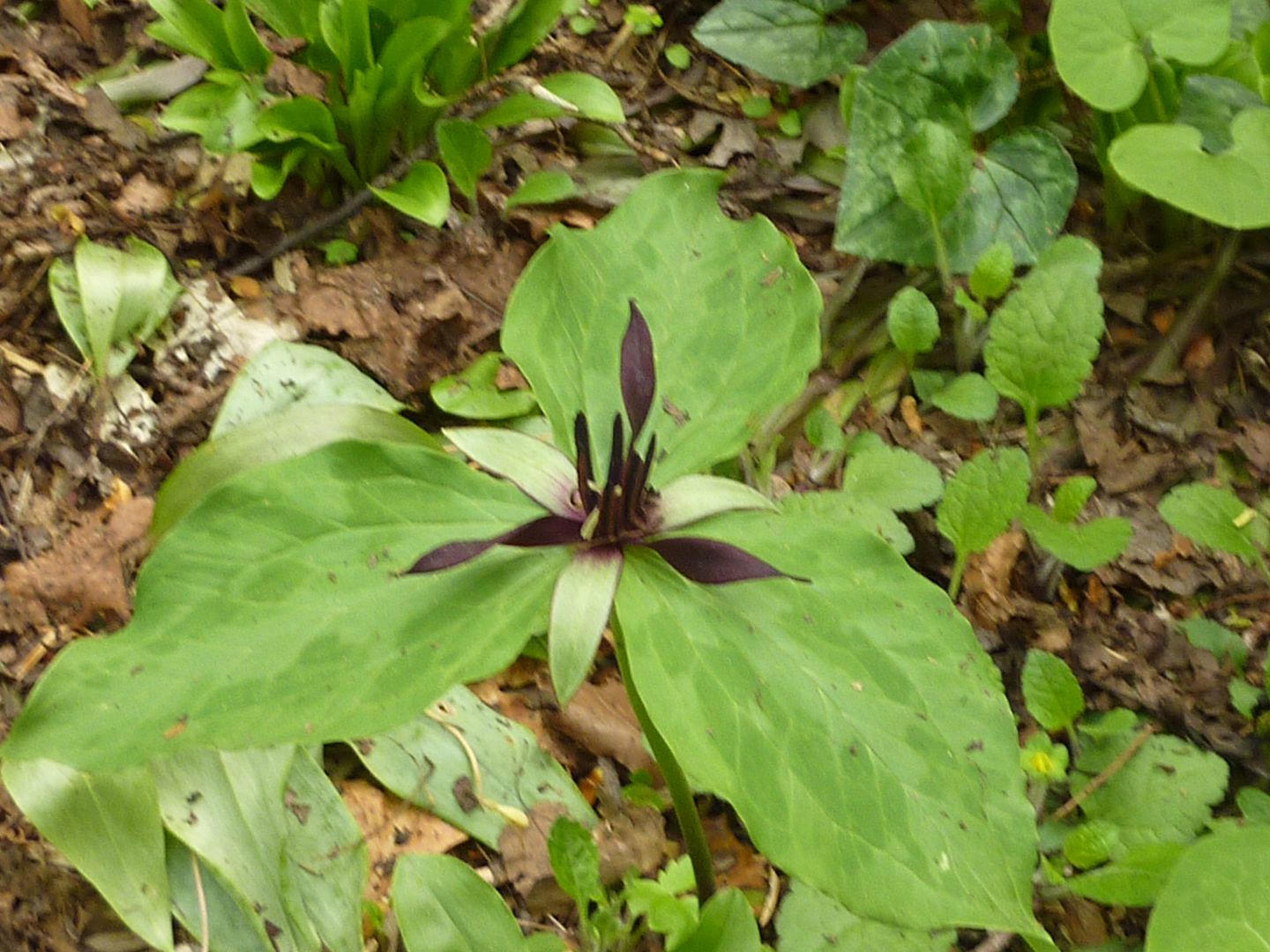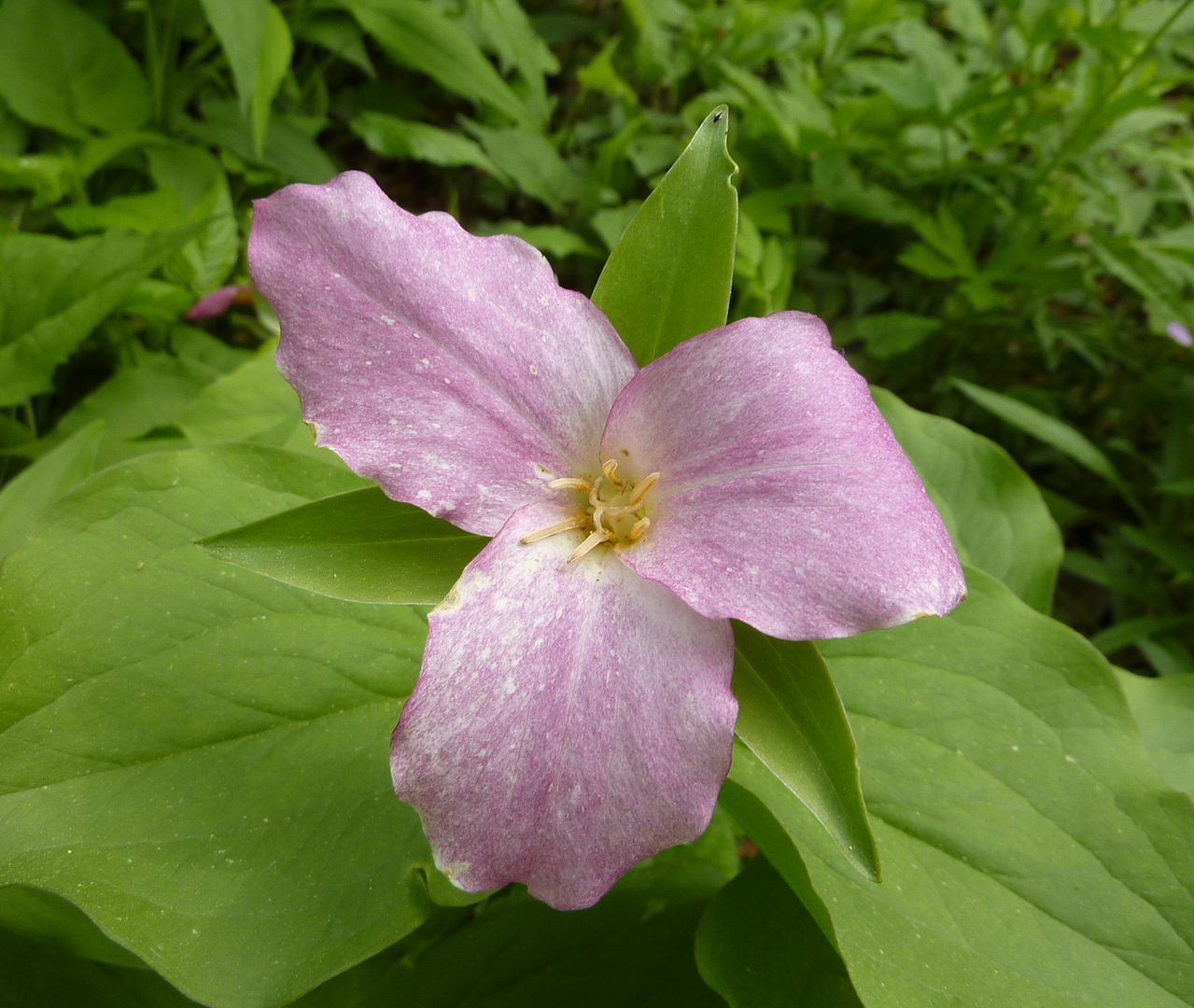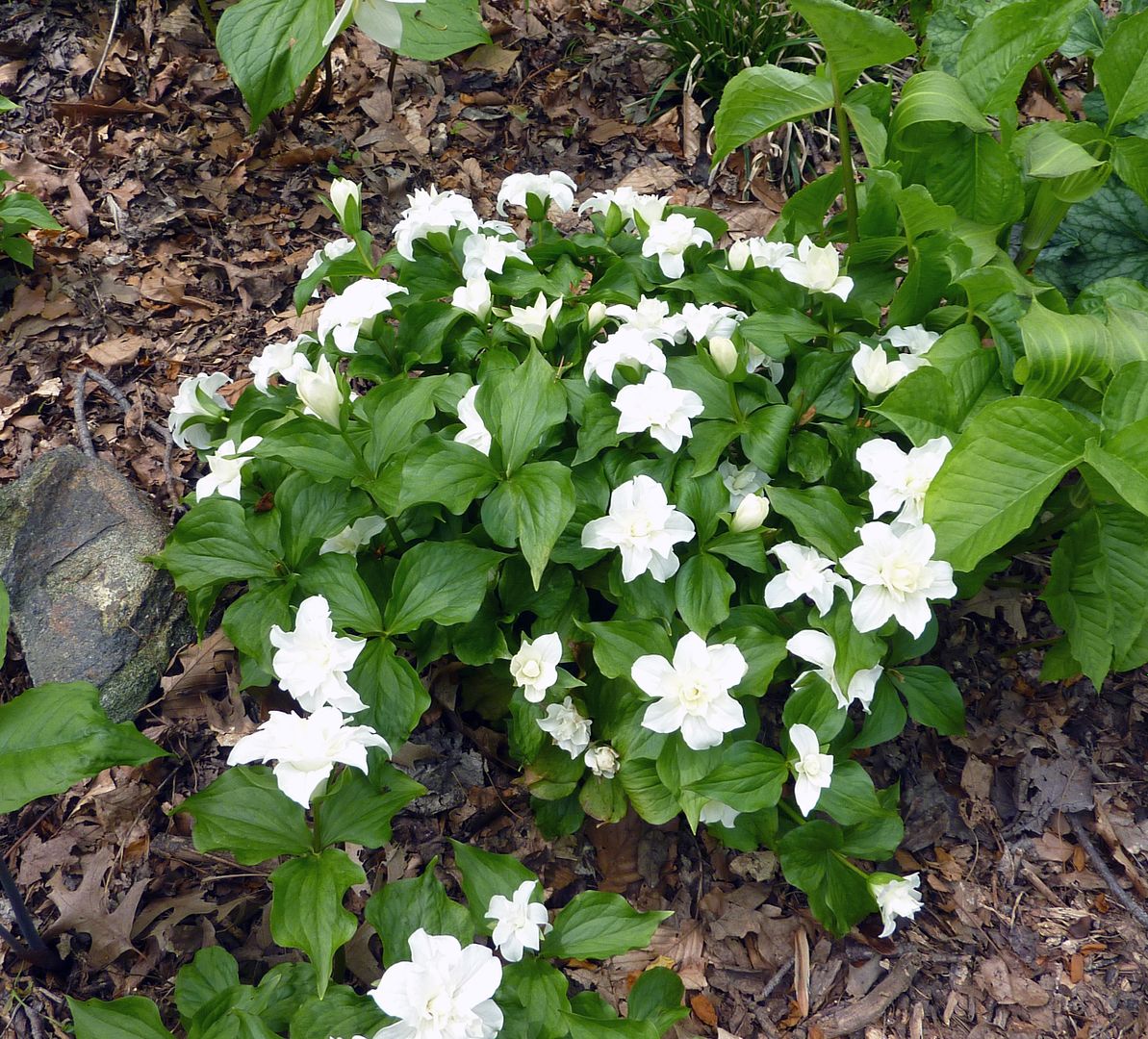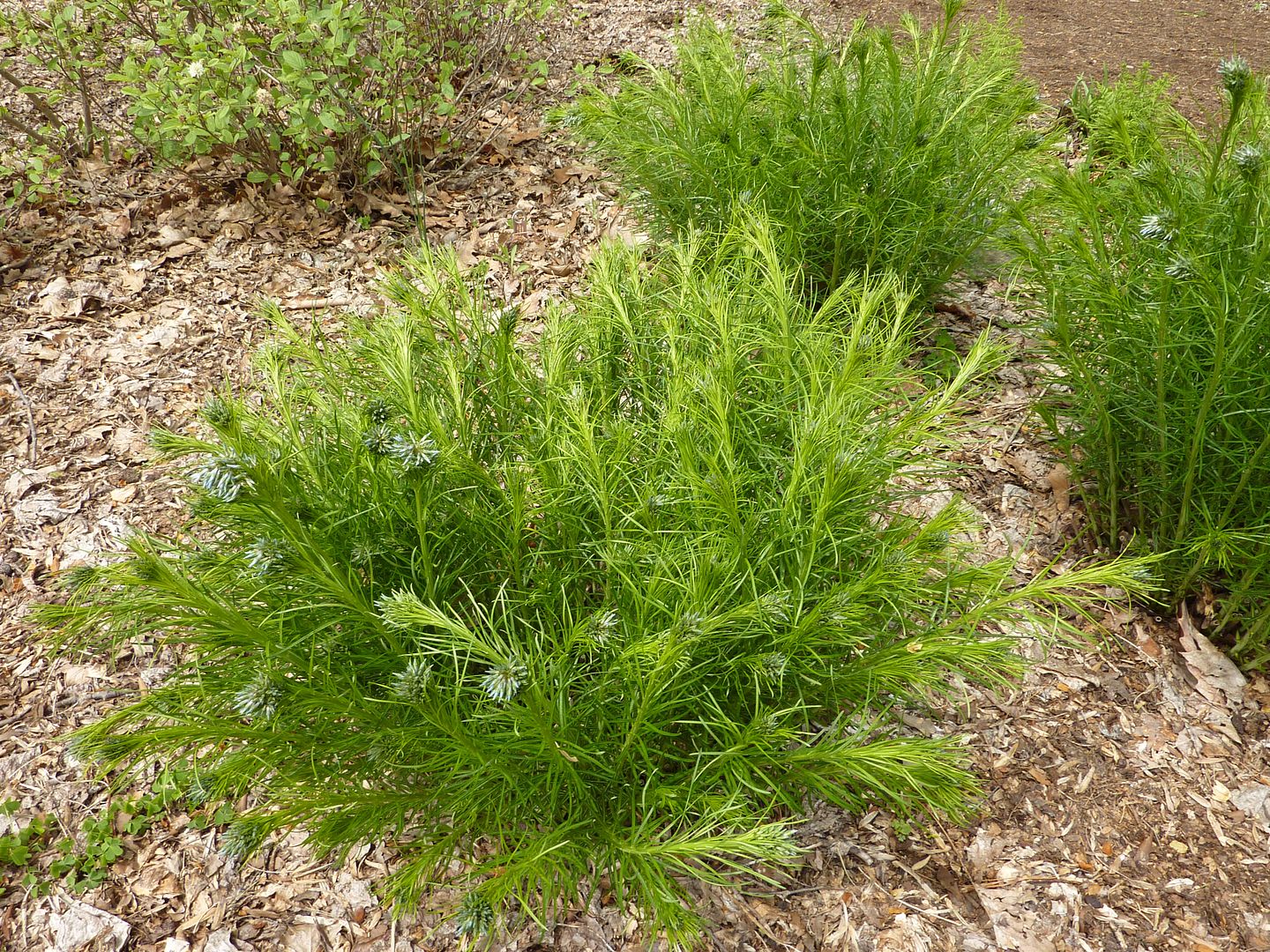Today my honeybees finally decided to swarm. See if you can find them in the picture above. They're in one of the trees.
They're that giant brown pine cone looking thing in the middle there. Honeybee hives divide each year as a way of reproduction. A new queen takes over the work of her mother at the original nest site, while the original queen and about 40% to 60% of the bees take flight to setup shop elsewhere.
Often they land somewhere near the hive to start out. This tree is in our yard. While there scouts explore the neighborhood looking for someplace to setup. If they don't find what they're looking for then they'll eventually just move where they're hanging out.
And sure enough that's what happened. They took to the sky, and I ran to my car grabbing my camera along the way to film an episode of Swarm Chasers, soon to be complete with the theme of Police Squad blaring in the back.
Naturally they landed only 2 blocks away and will keep this patter up of swarming from one tree/bush to another until a suitable home is found. They're still to high up for me to get, and the home owner said he'd rather not let me rile them up. He said he's allergic which I tend to believe, though most people make it up. That's fine with me, I still have a hive and split I'm nurturing into a productive state. I told him they'll likely fly off early tomorrow morning so there's no need to spray them or anything like that, I left him my name and number, told him where I live, and drove off.
Sometimes you just have to let it fly.
Tuesday, May 31, 2011
Monday, May 30, 2011
Jumping on the Right Gardening Bandwagon
Garden themes are a dime a dozen these days, though not quite as bad as the Diet and Exercise industry. Some of these are gimmicky, while others are classic categories handed down for generations. Really I want gardeners everywhere to just take two steps back and ask where the industry is going.
Compost Tea -
Okay I've never tired this personally but it seems to me hosing down the food with compost isn't as much of a good idea as you might think. What isn't mentioned here is you can occasionally grow Escherichia coli in the tea, also known as E. coli. Also 8 cups of compost sounds like a lot. 1 quart is what other folks online seem to be saying.
Hydroculture - Basically this is the stupid thing to the below. Actually it's wrong to call it stupid because it actually works. It's just you can't grow anything with a grow light alone. You need to have it next to a window to really grow anything out of it. Basically you're growing plants without soil, they survive because there's an air bubbler constantly feeding the roots air and ever two weeks or so you dump in a pill capsule of nutrients. This works but it feels anything but natural.
Aquaculture - This is the biggest waste of money unless you have a garage or green house devoted to it. The idea is the same as Hydroculture but instead of adding nutrients you have fish (usually Tilapia, Koi or Goldfish) living in a tank and the water is filtered through the growing beds. On a large scale I can see this working but as something to be put in your home or apartment it just doesn't work. I tried one product that cost $200+ which grew more mold gnats than anything edible. It must be placed next to a window to get the right amount of light and even then you will need a grow light over it. There isn't enough light coming in through your house windows to grow any edible plant. But if to much light hits the fish tank you'll get green algae which will suck up all the nutrients. In the home these really need to be in the right spot or it's all going to fail.
A few places do this on large scale and are more impressive. The issue though is because they're supplying food to the public and or allowing people to walk around and view their setup, they have to have the water tested daily to make sure E. coli isn't a concern.
Topsy Turvy Tomato and Herb Planter
This sounds as stupid as it looks. Plants want to grow up, not down. They don't hole enough soil either. You're better off just growing a plant inside a bucket. Moving on.
Permaculture - I love the idea here. Basically you garden as a forest. Tall trees are nitrogen fixing with their leaves every year, or otherwise a food crop in some right, vines are allowed to grow up and around them for more food production, shrubs are all food producing, The understory is a mix of shade tolerant plants that all serve some purpose in producing food. As we go farther out into more sun lit areas we find the traditional fruits and vegetables growing. And there's a cycle happening here as the trees drop their branches for firewood, or other material, so that everything is recycled and interconnected in the same system. Basically every plant here should be useful, there's no need for a lawnmower or anything like that other than to add to the compost pile.
What I hate about is when Permaculture nuts recommend stupid plants. YOU ARE NOT going to make your own paper or re-shingle your own house using bamboo. Anyone growing Trilliums as a source of toilet paper is an idiot. Perennial Sunflowers aren't all they're cracked up to be and frankly fall over on everything.
Crop Rotation - Okay this makes sense. It's actually grounded in reality. The idea is certain crops promote or use different nutrients in the soil. So one year you grow tomatoes, and the next year you move those to another spot, etc... Farmers used to do this a lot but used livestock and whatever crop they happen to be growing.
Square Foot Gardening -
With this we're still rotating the crops but they're being grown inter mingled as communities with different root types as opposed to a small mono-culture. This makes sense to me and is very similar to how I have my garden arranged. Along with working, it makes the garden look more like a landscape or flower arrangement almost. There's some design and ascetic qualities to take into account, or even if that's not your thing then it really doesn't matter because it all needs to grow together somehow.
Hummingbird Garden - These don't produce anything other than that is to say they attract hummingbirds. There are a lot of plants at nurseries that say they attract hummingbirds, so many in fact it leads one to believe that there are hummingbirds everywhere just around every corner you don't happen to be looking at right now. Where a lot of gardeners go wrong is actually believing these labels instead of doing research. If you're in the natural range of Coral Honeysuckle, Lonicera sempervirens, then you should have several of these planted in your garden! This is one of the plants these birds migrate with the bloom of and it does a hell of a lot better than Japanese Honeysuckle, Lonicera japonica which gets nothing but carpenter bees.
You'll hear other tips like, "include plants that get lots of insects," and, "always have a few evergreens nearby for them to nest in."
Now, I understand the second one, though I'll point out I've seen them nesting more openly at times. As for the first one... "include plants that get lots of insects,"... Where the hell did this come from? Considering the years and years of gardening mentality that is bugs are bad how the hell did these words come out of a gardener's mouth? What plant at the nursery has ever been labeled that? The only one that comes to mind is New Jersey Tea, Ceanothus americanus, which is really hard to find in most garden centers, and from my understanding has been on serious decline over the past 50 years! I think what they mean by lots of bugs really is that it gets lots of aphids and things like hover flies for them to eat. Caterpillars are also high on the menu.
Butterfly Garden - Here's another theme that a lot of gardeners go wrong with thanks to garden labels. There are a lot of videos online that stress the use of both nectar plants and host plants, and frankly a lot of them talk down to their audience in the process. It's okay to have a butterfly bush, in states where it's not considered a noxious weed, but I would rather have Ironweed, assorted Liatris, assorted Milkweed, some Joe Pye Weeds, Wild Senna, Buttonbush, Asters and Goldenrod all growing in the same 10 by 10 area one butterfly bush can take up.
One problem often talked about with butterfly gardeners is they never seem to have enough insects! Found in the what many call the bible of our age, Bringing Nature Home: How You Can Sustain Wildlife with Native Plants, Updated and Expanded Doug Tallamy has created a list of host plants, also available online! Woody Plants, Herbaceous Plants. So generally if you have a forest and prairie themed garden full of mostly natives you're doing great. Unfortunately most Lepidoptera are moths. Butterflies are actually a rather small group as a whole and considered to just be day time flying moths. To really get those host plants for each should be researched individually.
Doug Tallamy has created a list of host plants, also available online! Woody Plants, Herbaceous Plants. So generally if you have a forest and prairie themed garden full of mostly natives you're doing great. Unfortunately most Lepidoptera are moths. Butterflies are actually a rather small group as a whole and considered to just be day time flying moths. To really get those host plants for each should be researched individually.
Vegetable Garden - Consequently, one problem often talked about with vegetable gardeners is they always have to many insects! I've caught my neighbor throwing Tomato Horn Worms over the fence cause she knows how much I love caterpillars. I'm often parted with how I should react in that situation.
Pollinator Garden - These are big with bee keepers mostly but include elements of butterfly and hummingbird gardens usually. As I've already talked about the other two I'll focus on the honeybee aspect. Going to beekeeping meetings and reading the newsletter often has me cringing at some of the recommendation people have. Often they're promoting down right invasive weeds as nectar sources. I refuse to promote what they are and I'll be posting a list of Native Plants for Honey Bees later in the year.
Xeriscaping - This is when plants are selected for their drought tolerant ability, often with a desert or rock garden theme. I like it but I don't feel that's it's meant for all areas. We have cacti all over, even here in New Jersey, but an entire garden devoted to it doesn't sounds right.
Rain Garden - Quite possibly the best choice of the lot. Water is collected, usually as run off from the gutters, and directed into a little pond or vernal pool, where plants often native and used in other categories above to filter the water. There's no fuss and no muss with this. It's just a water conscious garden.
Conclusions - So regardless of what you're doing and how your growing things, the underlying theme needs to be as follows. It is better to be pretty useful as opposed to just looking pretty. All exceptions must be native to within at least your region of the country. And it's that simple.
Compost Tea -
Okay I've never tired this personally but it seems to me hosing down the food with compost isn't as much of a good idea as you might think. What isn't mentioned here is you can occasionally grow Escherichia coli in the tea, also known as E. coli. Also 8 cups of compost sounds like a lot. 1 quart is what other folks online seem to be saying.
Hydroculture - Basically this is the stupid thing to the below. Actually it's wrong to call it stupid because it actually works. It's just you can't grow anything with a grow light alone. You need to have it next to a window to really grow anything out of it. Basically you're growing plants without soil, they survive because there's an air bubbler constantly feeding the roots air and ever two weeks or so you dump in a pill capsule of nutrients. This works but it feels anything but natural.
Aquaculture - This is the biggest waste of money unless you have a garage or green house devoted to it. The idea is the same as Hydroculture but instead of adding nutrients you have fish (usually Tilapia, Koi or Goldfish) living in a tank and the water is filtered through the growing beds. On a large scale I can see this working but as something to be put in your home or apartment it just doesn't work. I tried one product that cost $200+ which grew more mold gnats than anything edible. It must be placed next to a window to get the right amount of light and even then you will need a grow light over it. There isn't enough light coming in through your house windows to grow any edible plant. But if to much light hits the fish tank you'll get green algae which will suck up all the nutrients. In the home these really need to be in the right spot or it's all going to fail.
A few places do this on large scale and are more impressive. The issue though is because they're supplying food to the public and or allowing people to walk around and view their setup, they have to have the water tested daily to make sure E. coli isn't a concern.
Topsy Turvy Tomato and Herb Planter
This sounds as stupid as it looks. Plants want to grow up, not down. They don't hole enough soil either. You're better off just growing a plant inside a bucket. Moving on.
Permaculture - I love the idea here. Basically you garden as a forest. Tall trees are nitrogen fixing with their leaves every year, or otherwise a food crop in some right, vines are allowed to grow up and around them for more food production, shrubs are all food producing, The understory is a mix of shade tolerant plants that all serve some purpose in producing food. As we go farther out into more sun lit areas we find the traditional fruits and vegetables growing. And there's a cycle happening here as the trees drop their branches for firewood, or other material, so that everything is recycled and interconnected in the same system. Basically every plant here should be useful, there's no need for a lawnmower or anything like that other than to add to the compost pile.
What I hate about is when Permaculture nuts recommend stupid plants. YOU ARE NOT going to make your own paper or re-shingle your own house using bamboo. Anyone growing Trilliums as a source of toilet paper is an idiot. Perennial Sunflowers aren't all they're cracked up to be and frankly fall over on everything.
Crop Rotation - Okay this makes sense. It's actually grounded in reality. The idea is certain crops promote or use different nutrients in the soil. So one year you grow tomatoes, and the next year you move those to another spot, etc... Farmers used to do this a lot but used livestock and whatever crop they happen to be growing.
Square Foot Gardening -
With this we're still rotating the crops but they're being grown inter mingled as communities with different root types as opposed to a small mono-culture. This makes sense to me and is very similar to how I have my garden arranged. Along with working, it makes the garden look more like a landscape or flower arrangement almost. There's some design and ascetic qualities to take into account, or even if that's not your thing then it really doesn't matter because it all needs to grow together somehow.
Hummingbird Garden - These don't produce anything other than that is to say they attract hummingbirds. There are a lot of plants at nurseries that say they attract hummingbirds, so many in fact it leads one to believe that there are hummingbirds everywhere just around every corner you don't happen to be looking at right now. Where a lot of gardeners go wrong is actually believing these labels instead of doing research. If you're in the natural range of Coral Honeysuckle, Lonicera sempervirens, then you should have several of these planted in your garden! This is one of the plants these birds migrate with the bloom of and it does a hell of a lot better than Japanese Honeysuckle, Lonicera japonica which gets nothing but carpenter bees.
You'll hear other tips like, "include plants that get lots of insects," and, "always have a few evergreens nearby for them to nest in."
Now, I understand the second one, though I'll point out I've seen them nesting more openly at times. As for the first one... "include plants that get lots of insects,"... Where the hell did this come from? Considering the years and years of gardening mentality that is bugs are bad how the hell did these words come out of a gardener's mouth? What plant at the nursery has ever been labeled that? The only one that comes to mind is New Jersey Tea, Ceanothus americanus, which is really hard to find in most garden centers, and from my understanding has been on serious decline over the past 50 years! I think what they mean by lots of bugs really is that it gets lots of aphids and things like hover flies for them to eat. Caterpillars are also high on the menu.
Butterfly Garden - Here's another theme that a lot of gardeners go wrong with thanks to garden labels. There are a lot of videos online that stress the use of both nectar plants and host plants, and frankly a lot of them talk down to their audience in the process. It's okay to have a butterfly bush, in states where it's not considered a noxious weed, but I would rather have Ironweed, assorted Liatris, assorted Milkweed, some Joe Pye Weeds, Wild Senna, Buttonbush, Asters and Goldenrod all growing in the same 10 by 10 area one butterfly bush can take up.
One problem often talked about with butterfly gardeners is they never seem to have enough insects! Found in the what many call the bible of our age, Bringing Nature Home: How You Can Sustain Wildlife with Native Plants, Updated and Expanded
Vegetable Garden - Consequently, one problem often talked about with vegetable gardeners is they always have to many insects! I've caught my neighbor throwing Tomato Horn Worms over the fence cause she knows how much I love caterpillars. I'm often parted with how I should react in that situation.
Pollinator Garden - These are big with bee keepers mostly but include elements of butterfly and hummingbird gardens usually. As I've already talked about the other two I'll focus on the honeybee aspect. Going to beekeeping meetings and reading the newsletter often has me cringing at some of the recommendation people have. Often they're promoting down right invasive weeds as nectar sources. I refuse to promote what they are and I'll be posting a list of Native Plants for Honey Bees later in the year.
Xeriscaping - This is when plants are selected for their drought tolerant ability, often with a desert or rock garden theme. I like it but I don't feel that's it's meant for all areas. We have cacti all over, even here in New Jersey, but an entire garden devoted to it doesn't sounds right.
Rain Garden - Quite possibly the best choice of the lot. Water is collected, usually as run off from the gutters, and directed into a little pond or vernal pool, where plants often native and used in other categories above to filter the water. There's no fuss and no muss with this. It's just a water conscious garden.
Conclusions - So regardless of what you're doing and how your growing things, the underlying theme needs to be as follows. It is better to be pretty useful as opposed to just looking pretty. All exceptions must be native to within at least your region of the country. And it's that simple.
Saturday, May 28, 2011
Some Camponotus Queens
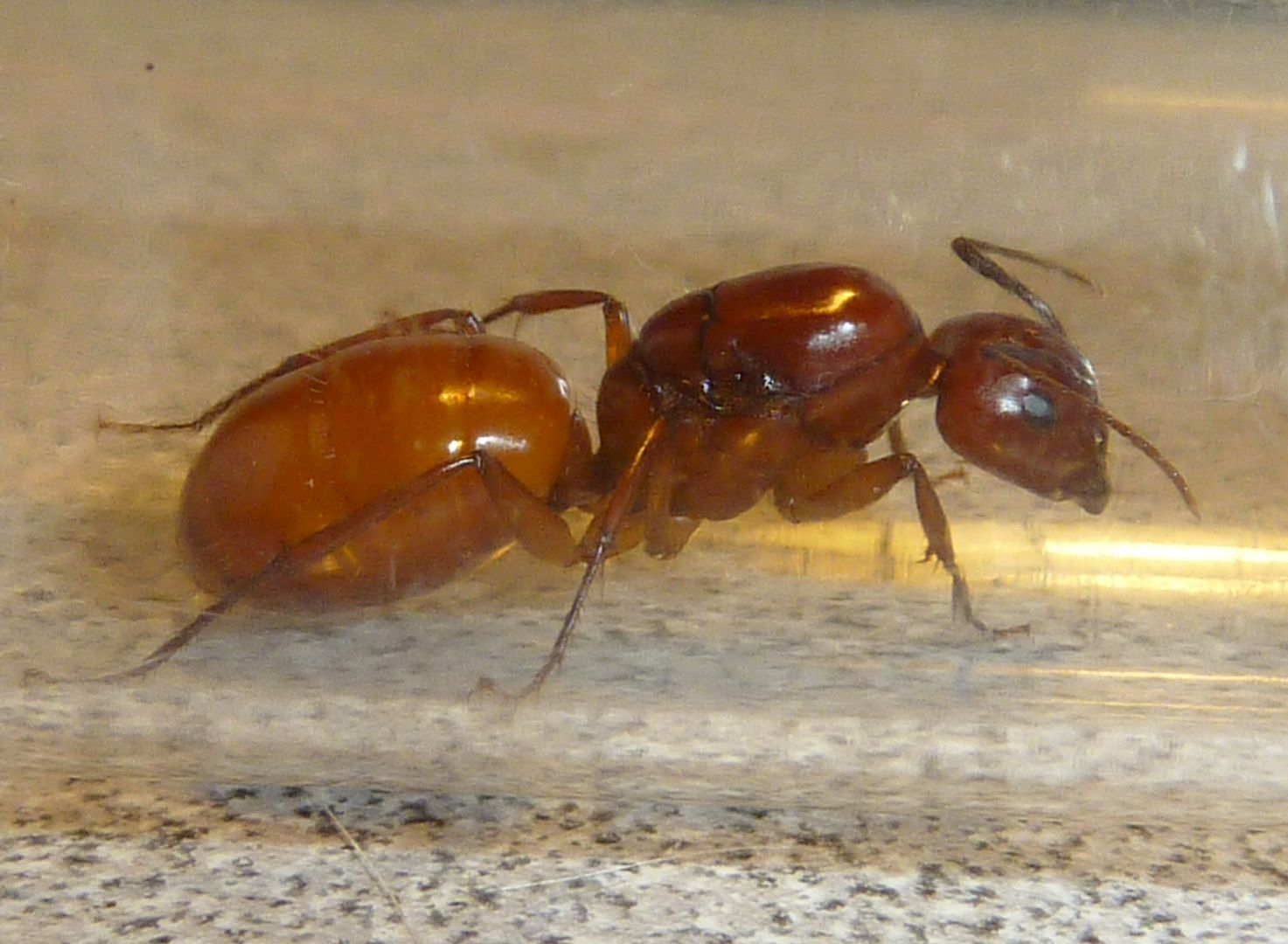 |
| Camponotus castaneus queen. |
 |
| Camponotus species queen. |
Friday, May 27, 2011
Blue False Indigo
This is Blue False Indigo, Baptisia australis, and after... 3 or 4 years in the garden it's Finally started flowering! I bought this as a 3 gallon pot from some nursery around here and it's taken this long just to start blooming. Normally when you buy a plant it's flowering in the pot so that's outrageous.
It's in a fairly ideal position in the garden. It gets full sun, I water it whenever it droops, it doesn't have any real pest issues. It's the host plant to a few moths and butterflies but nothing that completely defoliates the plant. An odd thing I've noticed is at the tips of each stem there is a shrived end, as if each stem could have grown taller but the plant said No Stop Here. I've seen it in past years and assumed those were flowers that failed to form. Now that's flowering well I still see them at the ends of some stems but clearly most of the buds formed.
I was always annoyed by the common name, False Indigo, but now that I see it in person I kind of agree with it. Even between my two pictures here you can see a real color difference despite my using the same camera, without a flash. The only difference was the time of day each photo was taken.
It's in a fairly ideal position in the garden. It gets full sun, I water it whenever it droops, it doesn't have any real pest issues. It's the host plant to a few moths and butterflies but nothing that completely defoliates the plant. An odd thing I've noticed is at the tips of each stem there is a shrived end, as if each stem could have grown taller but the plant said No Stop Here. I've seen it in past years and assumed those were flowers that failed to form. Now that's flowering well I still see them at the ends of some stems but clearly most of the buds formed.
I was always annoyed by the common name, False Indigo, but now that I see it in person I kind of agree with it. Even between my two pictures here you can see a real color difference despite my using the same camera, without a flash. The only difference was the time of day each photo was taken.
Wednesday, May 25, 2011
In this episode I highlight the various aphid "infestations" springing up on various plants. As wildflowers fade, stealing nectar from plants becomes harder to rely on. Aphids circumvent plant defenses and share their spoils to attract the ants to them as guardians. They don't do a perfect job but they do it well enough that aphid herds maintain fair sized populations.
Saturday, May 21, 2011
Formica pergandei Give a Head Start
I have two Formica colonies started from queens last year. One is Formica pallidefulva and she started laying eggs maybe a month and a half to two months ago. She's already got some fresh workers born for the year and it looks like the colony will continue to grow well into the autumn. The other colony I have is interesting though, Formica pergandei.
Formica pergandei is a social parasite of other Formica species. That is F. pergandei queens can't start a colony on their own. They have to invade established colonies of hosts and replace it's resident queen, usually by assassination and stealing the colony odor by rolling in the queen's juices, etc... so the host workers don't turn on here.
This picture was taken yesterday. Note the eggs scattered about as well the large clutch the worker in the middle is holding. As a social parasite she started laying eggs about a month later than the host species.
She may produce workers but sometimes social parasites are so dependent to their host species that they're required for their survival. The trouble is the F. pergandei queen had to replace the F. pallidefulva queen in order to start her colony, so they're eventually going to run out of host workers.
F. pergandei colonies get around this by raiding established host colonies for brood. Occasionally I believe host colonies are out right overrun by the F. pergandei as they move their entire nest into the new location. It's a vicious cycle but at least the F. pergandei are giving their hosts a chance to get a head start. Come summer though the F. pergandei will be born and raids will begin.
Formica pergandei is a social parasite of other Formica species. That is F. pergandei queens can't start a colony on their own. They have to invade established colonies of hosts and replace it's resident queen, usually by assassination and stealing the colony odor by rolling in the queen's juices, etc... so the host workers don't turn on here.
This picture was taken yesterday. Note the eggs scattered about as well the large clutch the worker in the middle is holding. As a social parasite she started laying eggs about a month later than the host species.
She may produce workers but sometimes social parasites are so dependent to their host species that they're required for their survival. The trouble is the F. pergandei queen had to replace the F. pallidefulva queen in order to start her colony, so they're eventually going to run out of host workers.
F. pergandei colonies get around this by raiding established host colonies for brood. Occasionally I believe host colonies are out right overrun by the F. pergandei as they move their entire nest into the new location. It's a vicious cycle but at least the F. pergandei are giving their hosts a chance to get a head start. Come summer though the F. pergandei will be born and raids will begin.
Thursday, May 19, 2011
Growing a Greener World Natural Pest Control
Growing a Greener World: Natural Pest Control
Here is a link to a fairly new episode to a garden show I really enjoy. Over the winter I think they stopped releasing episodes and I haven't visited their site until now. Time for me to get caught up. I was impressed with the level of information this show gives.
Also I noticed how naturally they tip toed the issue of the Multicolored Asian Lady Bug, Harmonia axyridis, an invasive species being sold for as organic pest control. They simply say buying adults isn't the best option because they tend to just fly away and can also transport disease. In a perfect world the sale of this species would be banned entirely. I'm happy to learn native species of lady bugs are available for sale.
Here is a link to a fairly new episode to a garden show I really enjoy. Over the winter I think they stopped releasing episodes and I haven't visited their site until now. Time for me to get caught up. I was impressed with the level of information this show gives.
Also I noticed how naturally they tip toed the issue of the Multicolored Asian Lady Bug, Harmonia axyridis, an invasive species being sold for as organic pest control. They simply say buying adults isn't the best option because they tend to just fly away and can also transport disease. In a perfect world the sale of this species would be banned entirely. I'm happy to learn native species of lady bugs are available for sale.
Tuesday, May 17, 2011
Balancing Ants and Aphids
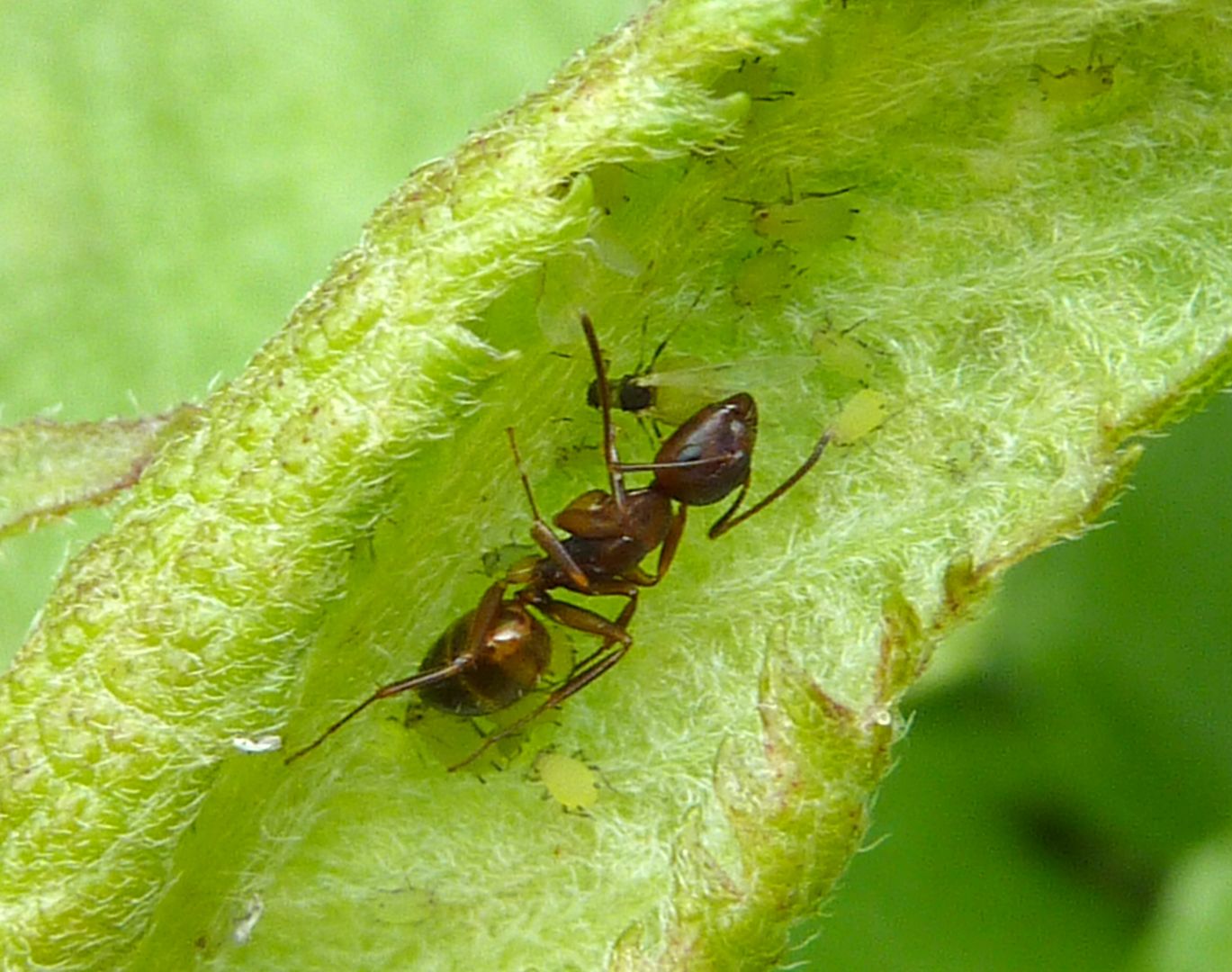 |
| Camponotus subbarbatus tending aphids. |
Also, something I noticed last year was that most aphid species in my yard seemed to finish their life cycle before summer really began. These were replaced by other aphids but found on different plants, red ones on Rudbeckia, orange ones on Milkweed etc... With the absence of aphids that also means the absence of hover fly larva, (pictured above) which feed on the aphids without the ants realizing it.
Parasitic wasps are another threat without ants around. I watched this one inject her eggs into several aphids but never got a good picture of it. Always she targeted the groups that didn't have ants guarding them.
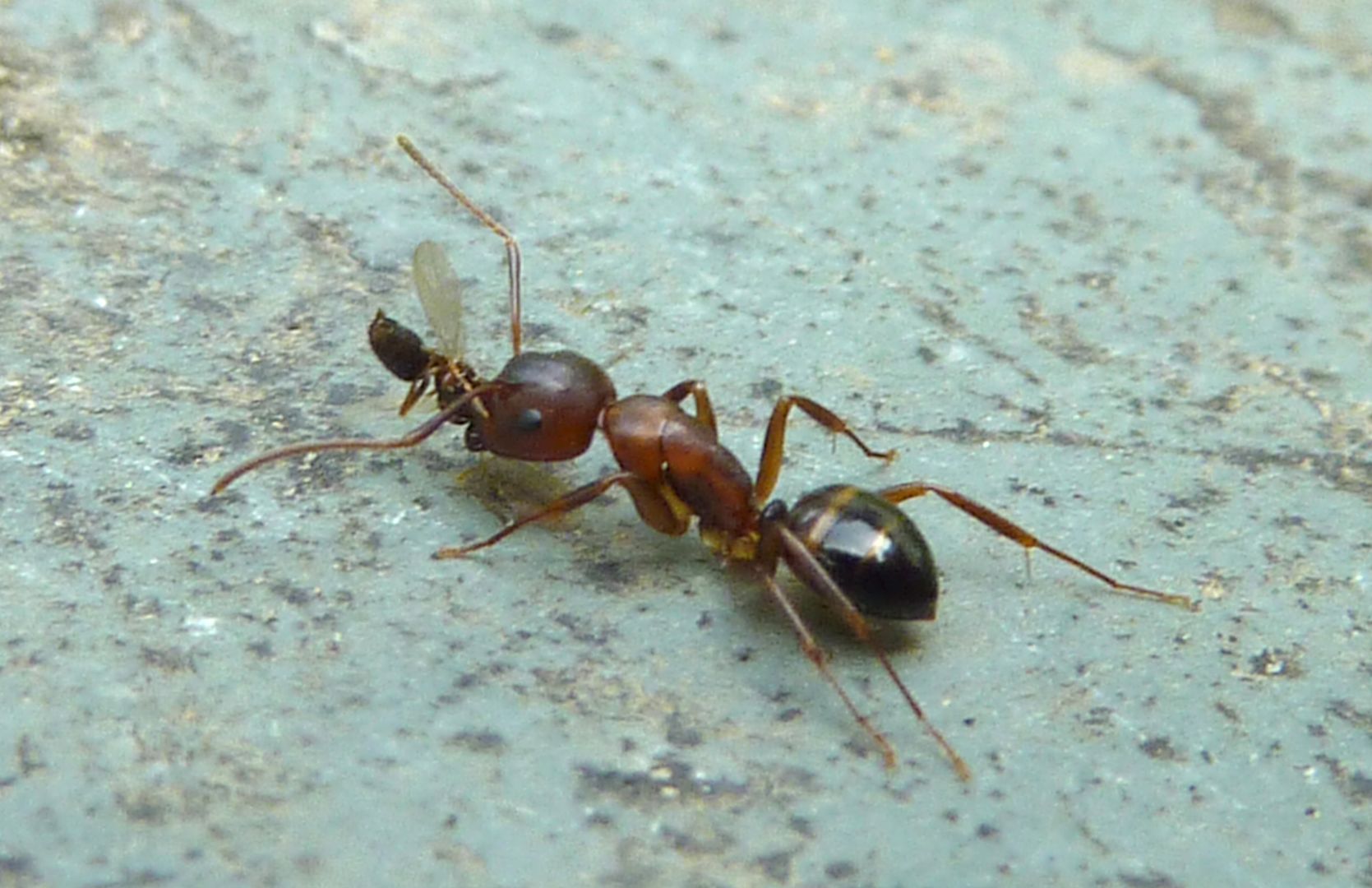 |
| Camponotus subbarbatus grasping a male Nylanderia flavipes. |
Come autumn nectar stores will be low once again. The colony diet will focus more towards sugars and the ants will be clambering for aphids and nectar once again.
Labels:
Ants,
Aphids,
Camponotus,
hover flies,
Parasitic,
Wasp
Sunday, May 15, 2011
Some Aphid Guardians
Formica subsericea (I think) either knowing the answer to a question I asked it, or clearly marking it's territory. By which I mean glaring at the camera and chasing me farther away from the precious aphid herds.
Aphids and other dew producing insects are finally becoming abundant enough to catch the attention of ants far and wide. Though some species prefer to collect the nectar second hand as tiny droplets drip down onto lower leaves.
This ant attention benefits the plant because the ants drive away insect herbivores. Some plants do this naturally by producing extra floral nectar, which also discourages the ants from stealing it from the flowers.
The downside for the plant is they can't control the number of aphids. This can be a real problem for the plant but typically it only inhibits the production of new growth and doesn't cause as much damage as a veracious horde of caterpillars. Some caterpillars can completely defoliate a host tree twice over in a year. So having some ants crawling all over to discourage or even remove the problem of caterpillars greatly benefits the plant.
A Lasius alienus tending some aphids on an Eastern Redbud.
Crematogaster cerasi blanketing over aphids on the stem to a Viburnum.
Crematogaster cerasi blanketing over aphids on the stem to a Viburnum.
Tapinoma sessile tending aphids on the stem to a Golden Alexander.
Tapinoma sessile tending aphids on the stem to a Golden Alexander.
Aphids and other dew producing insects are finally becoming abundant enough to catch the attention of ants far and wide. Though some species prefer to collect the nectar second hand as tiny droplets drip down onto lower leaves.
This ant attention benefits the plant because the ants drive away insect herbivores. Some plants do this naturally by producing extra floral nectar, which also discourages the ants from stealing it from the flowers.
The downside for the plant is they can't control the number of aphids. This can be a real problem for the plant but typically it only inhibits the production of new growth and doesn't cause as much damage as a veracious horde of caterpillars. Some caterpillars can completely defoliate a host tree twice over in a year. So having some ants crawling all over to discourage or even remove the problem of caterpillars greatly benefits the plant.
A Lasius alienus tending some aphids on an Eastern Redbud.
Crematogaster cerasi blanketing over aphids on the stem to a Viburnum.
Crematogaster cerasi blanketing over aphids on the stem to a Viburnum.
Tapinoma sessile tending aphids on the stem to a Golden Alexander.
Tapinoma sessile tending aphids on the stem to a Golden Alexander.
Saturday, May 14, 2011
Joe MacGrown has a YouTube Channel
So I just learned that Joe MacGown of the Mississippi Entomological Museum has a YouTube channel. I was showing a friend the most recent Ant Chat episode and they mentioned the species of Nylanderia, N. sp. near pubens. I didn't even know they gave it a name and upon seeing pictures of it I wondered if my ID for the local Nylanderia flavipus was correct. After watching the video I was assured what I have on my raspberries wasn't them. N. flavipus doesn't run insanely fast like that.
Now let's learn how to dissect a moth's genitals.
He's also quite the artiest.
Now let's learn how to dissect a moth's genitals.
He's also quite the artiest.
Monday, May 9, 2011
Ant Chat Episode 29: Nests and Foraging
Now that warm temperatures are a reoccurring theme for the year, ants take advantage of this time before summer's heat limits their activity. Some are prepare reproductive brood, while others opt to move, divide, or expand the nest in other ways. All this is done while carefully foraging and maintaining boarders with species that directly oppose their goals.
Foraging is typically done on the ground. Providing more spring ephemerals allows for greater surface area for the ants to explore, and perhaps bring them closer to eye level.
Aphids provide actual hot spots for ant food. Occasionally their populations grow out of hand for the host plant but they rarely kill the host. Some would argue resulting diseases if present.
Beneficial insects such as lady bugs, and hover fly larva help keep aphids from getting out of hand.
Nylanderia flavipes is an imported species. Though not invasive it's something of a tramp often found in potted plants.
Saturday, May 7, 2011
Hepatica Seed Myrmecochory Fail
So earlier today I was checking out the Hepatica and uhh... that little spike ball that grew where the flower was fell apart.
For some reason in my mind I was thinking each spike would open up as we see in violets and there would be the seeds inside. As it turns out, each of the spike point is a seed connected by a pinch of elaiosome found at the inner tip.
Elaiosome is a dead indicator of Myrmecochory, seed dispersal by ants. So naturally I took a pinch or two of seeds to put them by ants and see what they'd do.
I tried really hard to get this to work but failed each time. And I don't know why. Each time the ant would inspect the seed and lose interest completely after only a few licks. Aphaenogaster should be perfect at doing this but even they didn't care for the seeds. Wondering foragers out on patrol walked right over them. I even disturbed a colony later to see if I could get the ants to do something to the seeds. The result is pictured above but it's a misleading photo.
Here an opportunistic Nylanderia flavipes just walks right over three good seeds. The pockets of elaiosome rival the size of the ant itself. Formica, Camponotus, Crematogaster all had the same result.
The only ant that I found to have any interest in these seeds was the invasive Tetramorium species E. and even then I'm pretty sure they were more interested in the seed part than the elaiosome. The pavement ant clearly had more interest in the non-elaiosome side than and was trying to drag the seed home.
I didn't harvest all of the seed heads, and ended up planting the ones I did. I'm thinking they might not have been mature yet. However, they did seem to fall right off the plant with only a very light touch. I'll try again in two weeks if they're still there, but I might as well plant the rest from the flower heads I did disturb. The elaiosome connecting the seed to the plant might dry out.
For some reason in my mind I was thinking each spike would open up as we see in violets and there would be the seeds inside. As it turns out, each of the spike point is a seed connected by a pinch of elaiosome found at the inner tip.
Elaiosome is a dead indicator of Myrmecochory, seed dispersal by ants. So naturally I took a pinch or two of seeds to put them by ants and see what they'd do.
I tried really hard to get this to work but failed each time. And I don't know why. Each time the ant would inspect the seed and lose interest completely after only a few licks. Aphaenogaster should be perfect at doing this but even they didn't care for the seeds. Wondering foragers out on patrol walked right over them. I even disturbed a colony later to see if I could get the ants to do something to the seeds. The result is pictured above but it's a misleading photo.
Here an opportunistic Nylanderia flavipes just walks right over three good seeds. The pockets of elaiosome rival the size of the ant itself. Formica, Camponotus, Crematogaster all had the same result.
The only ant that I found to have any interest in these seeds was the invasive Tetramorium species E. and even then I'm pretty sure they were more interested in the seed part than the elaiosome. The pavement ant clearly had more interest in the non-elaiosome side than and was trying to drag the seed home.
I didn't harvest all of the seed heads, and ended up planting the ones I did. I'm thinking they might not have been mature yet. However, they did seem to fall right off the plant with only a very light touch. I'll try again in two weeks if they're still there, but I might as well plant the rest from the flower heads I did disturb. The elaiosome connecting the seed to the plant might dry out.
Friday, May 6, 2011
A Spider of a Different Color
I found that radioactive spider that bit the Joker... I think I have my comic books mixed up. Anyhow this neat looking spider was on the garden hose when I went to grab it. It lowered itself down onto a tire and posed nicely for the camera.
Thursday, May 5, 2011
Trillium Colors and Design
 |
| Trillium grandiflorum |
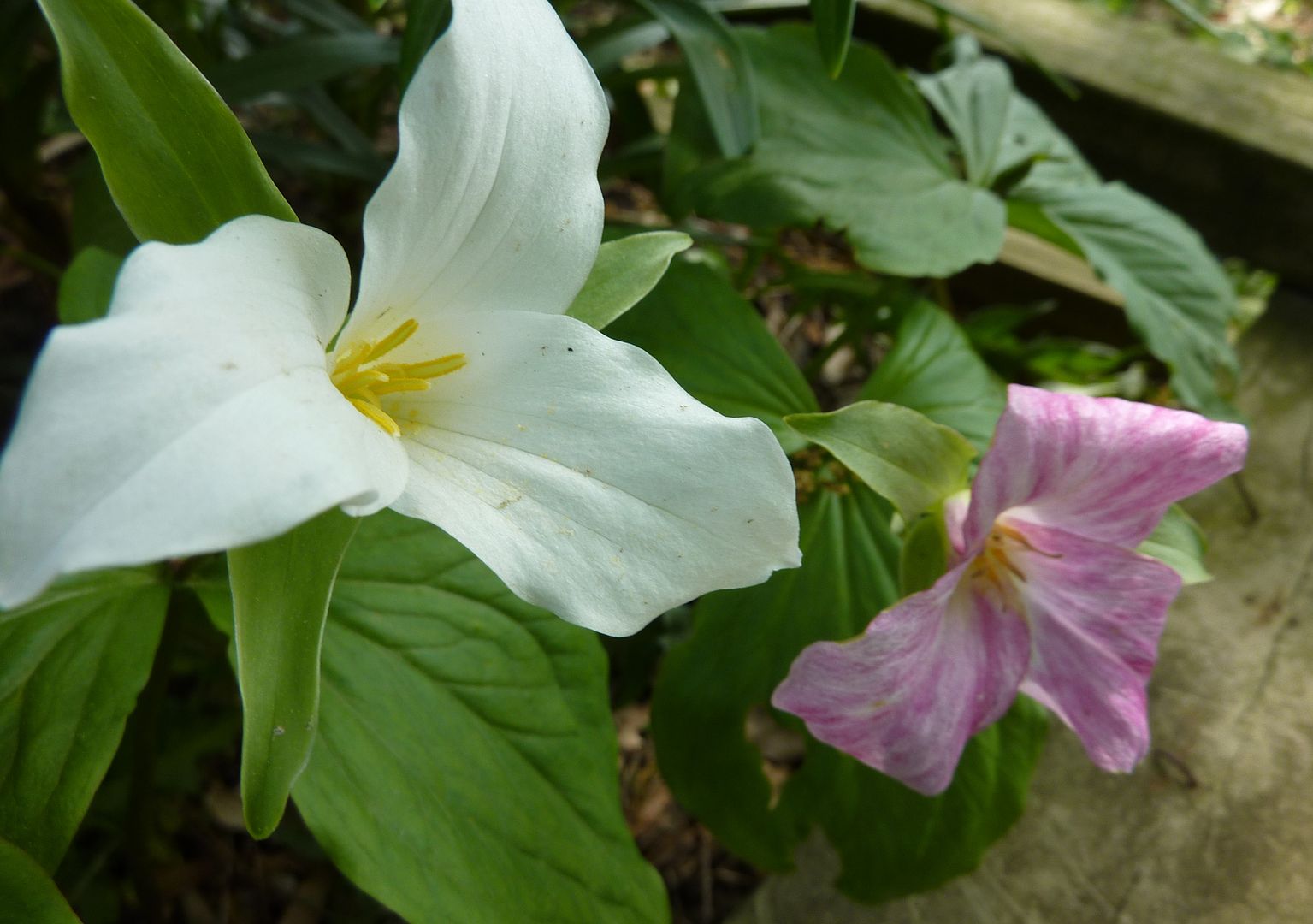 |
| Trillium grandiflorum |
 |
| Trillium grandiflorum |
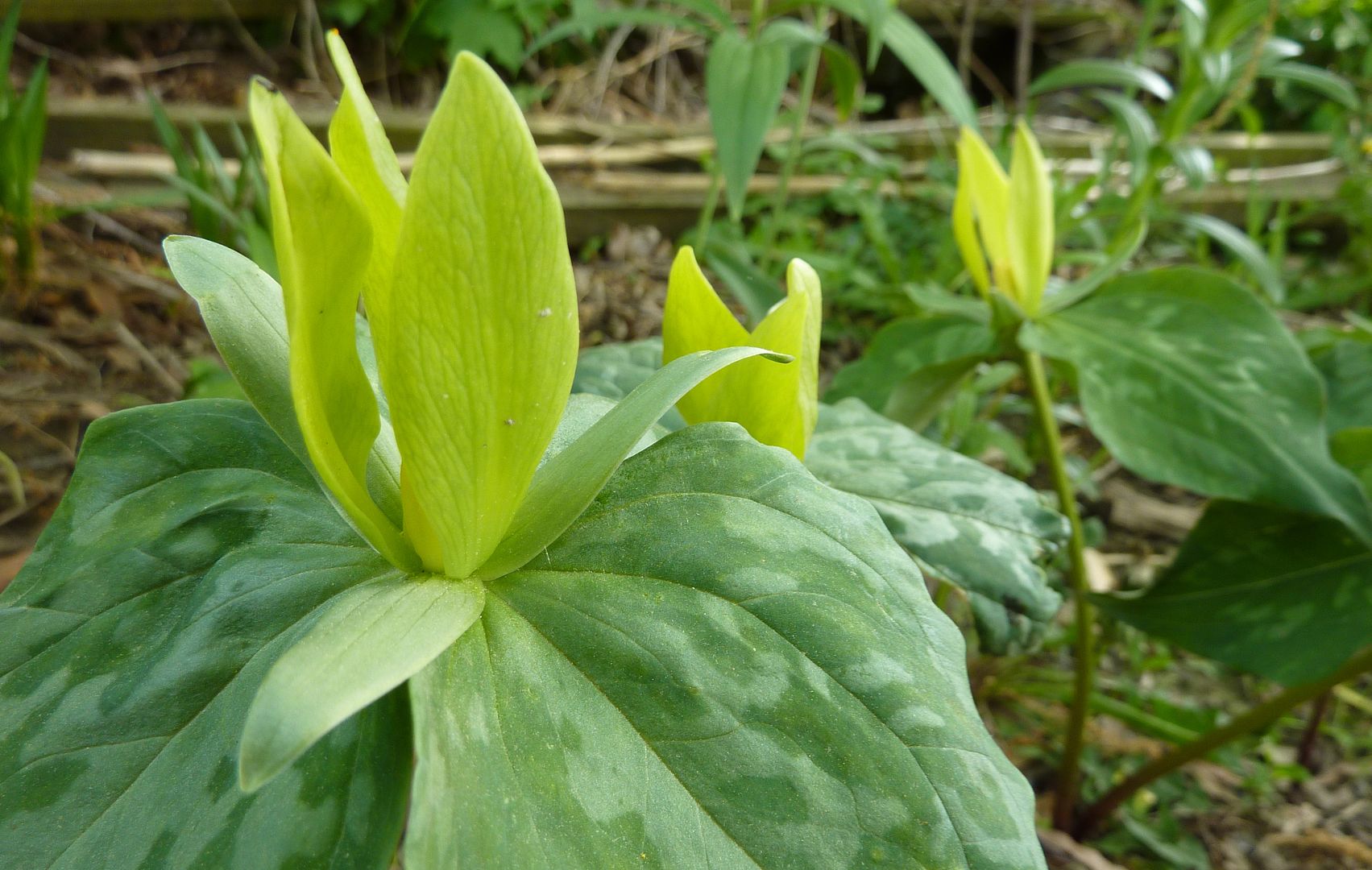 | ||
| Trillium luteum |
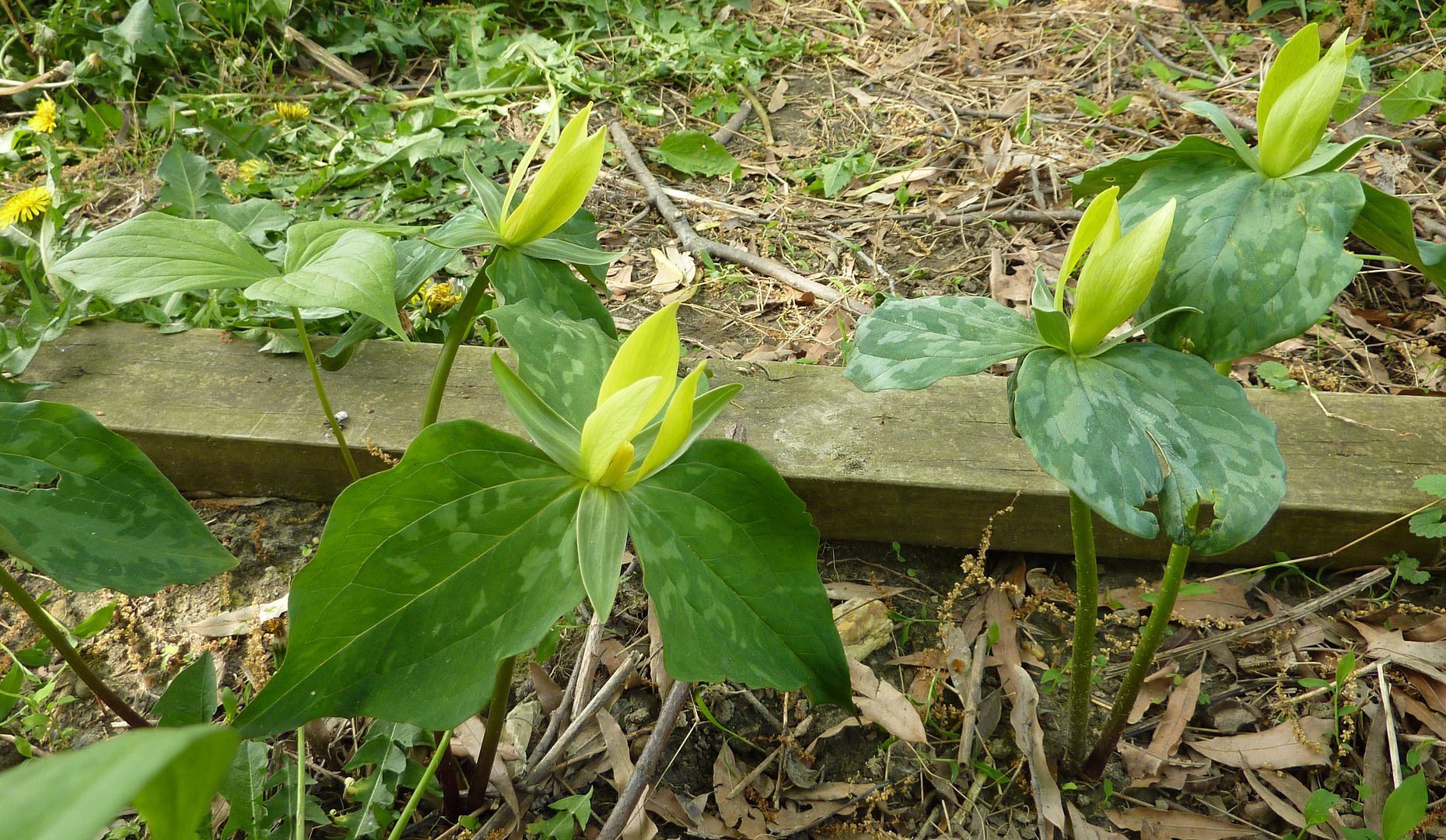 |
| Trillium luteum |
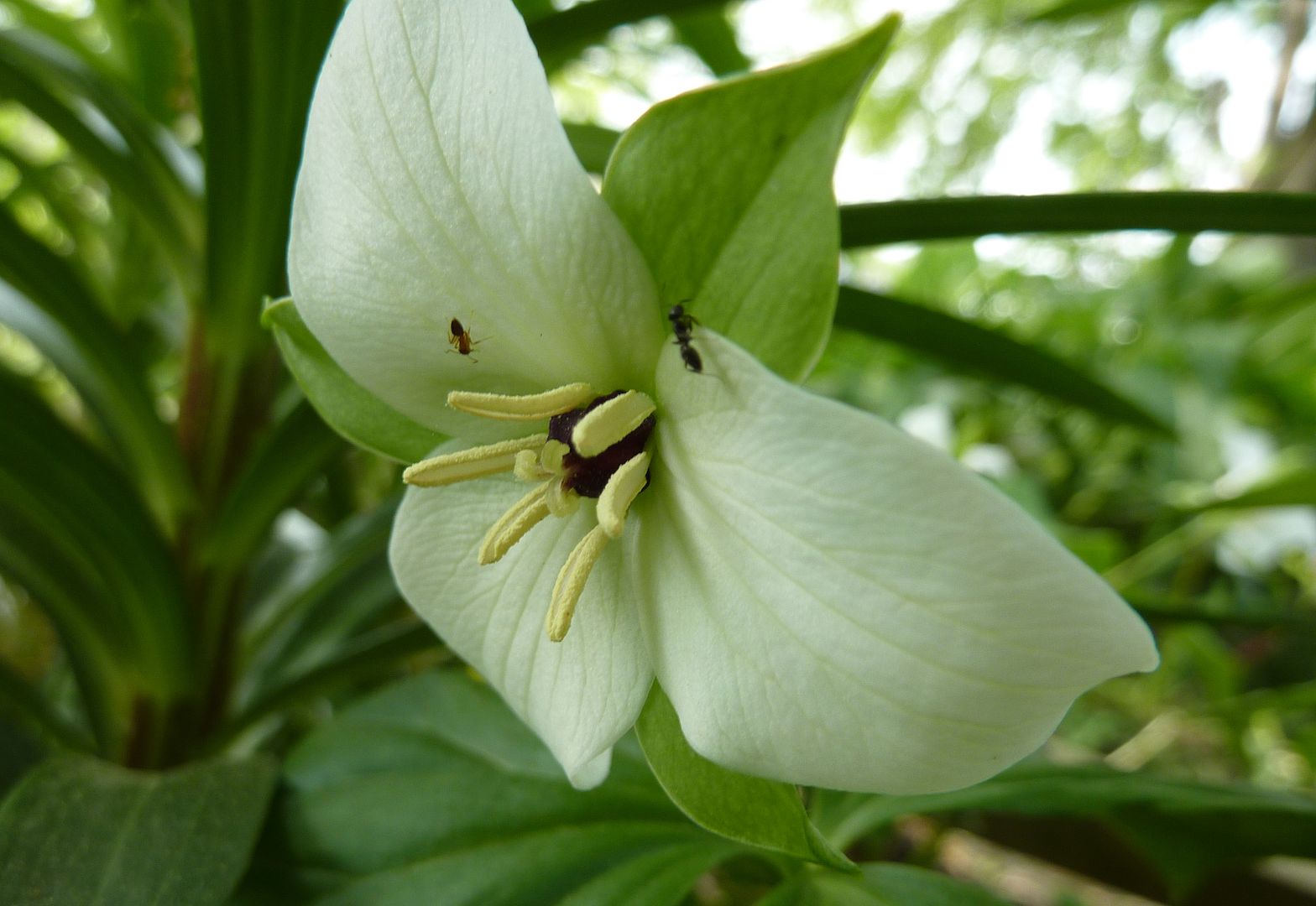 | ||
| A Tapinoma sessile and Nylanderia flavipes foraging on a Trillium simile flower. |
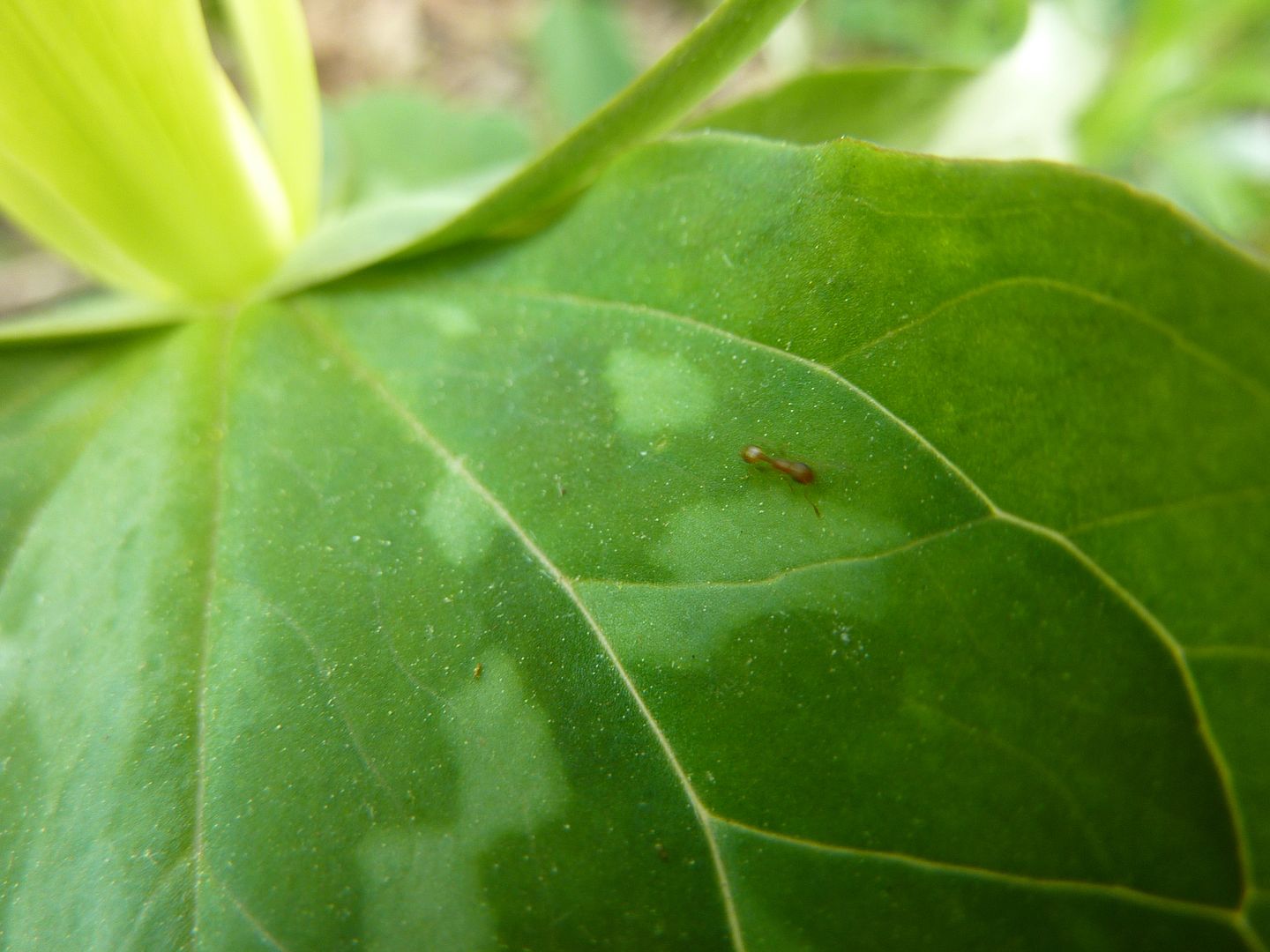 |
| Temnothorax species walking on Trillium luteum leaf. |
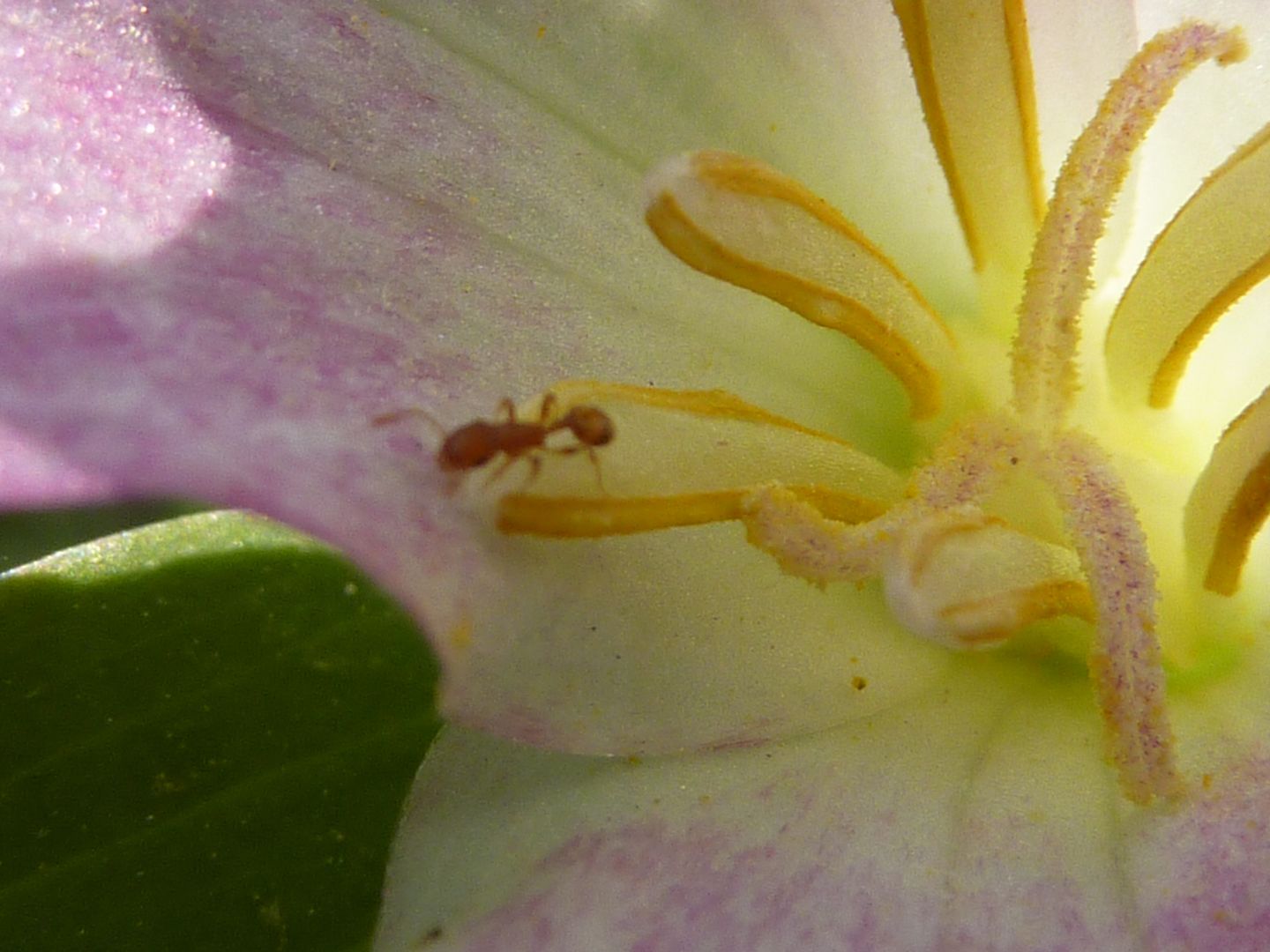 |
| Temnothorax species exiting Trillium grandiflorum flower. |
Labels:
Ants,
Color,
Design,
flowers,
Nylanderia,
Tapinoma,
Temnothorax,
Trillium
Monday, May 2, 2011
My 2011 Visit to the Mt. Cuba Center
On May 1st 2011 the Mt. Cuba Center held their 7th Annual Wildflower Festival and I'm happy to say it was a huge success. According to an article on Delaware Online an estimated 3,000 people showed up to roam the gardens that, in my opinion, rivals that of the Philadelphia International Flower Show. (They also report that the Mt. Cuba Center has some 50 species of Trillium, which I believe is an error. Their guide they sell only lists 24 species and it's not that old of a book. Perhaps they're including hybrids and cultivars that have sprung up over the years?)
Not only was it free to attend but the first 500 people were given a free plant. I was among the first 500 last year where I got a simple Coreopsis species. It didn't do very much but I see many shoots coming up this year and it's clearly seeded itself about. It's always wonderful to see a native plant doing that. This year, sadly I wasn't among the first 500 people, so no plant for me. This is a shame because I would have really enjoyed a free Bluestar! I'm not certain on the species, I think it was Amsonia tabernaemontana, or certainly one of the normal leafed Amsonia species. (Normal as in not thin.)
So without further delay, here's some of what you missed. Pictures are not in the order they were taken, but are arranged to have a sense of flow.
When first walking up to the Mt. Cuba Center I was hesitant to believe anything would be flowering at it's peak. I have a few of the same plants at my home garden and the theme last year seemed to be they were two weeks ahead of my garden. So here we are in 2011 and I'd expected everything to already be past it's peak as most of the Trillium species and the like seem to be on their way out at home. I'm happy to say my fears were not grounded in reality.
Sure bloom time may vary from year to year but the Mt. Cuba Center has such vast array of spring blooming wildflowers that there are always several dozen species reaching their peak bloom from week to week well into the summer. They also have the advantage of being on a hill with their own micro climate, so that same species at the top of the hill will be flowering differently than at the bottom. This extends the blooming season long enough that they have a wider window to hold their event.
Eastern Redbuds, Cercis canadensis, stood out in numerous places throughout the garden.
A lot of the other shrubs and trees weren't doing much though. Most Rhododendrons and Silver Bells weren't flowering at all.
White Flowering Dogwoods, Cornus florida, were a superb exception along with the redbud. They all seemed to be flowering at their peak on cue that day. My neighbor's tree flowers perfectly for about three days and then it's done, new leaves grow in and there's no white to be seen. At Mt. Cuba their clouds of white flowers are impossible to miss against the forest backdrop, so kudos to whoever picked the date.
Down on the forest edge floor, Bluets, Houstonia caerulea, sparkled in the patches of mass. The patch at the Mt. Cuba Center is a true highlight of the gardens.
The cluster is comprised of thousands of tiny white-blue flowers that each have 8 tiny gold dots in the center. As these are a new plant to my garden, I asked their expert gardener stationed nearby a quick question about them.
Basically I learned these do not hold up to foot traffic of any kind. It's best to grow them among moss in places where people rarely walk. They do send out runners, as you might see in some strawberries, but flowering reproduction is preferred and should be encouraged! Apparently runners are simply clones of the parent plant and it's believed that they are less likely to flower if they're simply cloning themselves. So seed production is a must for anyone interested in the snow effect seen above.
One plant that was a little past it's prime were the Swamp Pinks, Helonias bullata. I managed to find one in good flowering condition but most had already faded brown and were developing seeds. Note the pale blue anthers. This is also a threatened species, that's quite uncommon in the wild. I understand the flowers are like cotton candy to the Deer.
Yellow Lady Slippers, Cypripedium calceolus. This is another uncommon plant, and a favorite among plant poachers to dig up. My understanding is they don't respond well to transplanting and often die as a result of being disturbed while flowering. I'm not certain what the story is on their reproduction by seed but I imagen it's possible.
Showy Orchid, Galearis spectabilis, I believe. Maybe I should have taken the time to read that label conveniently just out of frame in the upper right. Anyhow these rare plants are always neat to find but I don't take much interest in things I can't really buy.
May Apple, Podophyllum peltatum. These plants have a wonderful flower that they keep hidden beneath two massive leaves.
Uvularia grandiflora, Bell Wort. This is a native I've never been interested in owning. I'm not sure what it is exactly. I guess you could describe it as a more manly version of Bleeding Hearts but I haven't come across anything in particular that catches my fancy with this one.
Foam Flowers, Tiarella cordifolia, planted among others in a garden. These were used heavily in places and make for a good primary plant to flow through an area. A theme the Mt. Cuba Center Gardeners use is planting in sweeps and somewhat natural looking flows. They do a great job, and often there will be one dominant plant used to guide you along while other plants accent your way.
Phacelia bipinnatifida is the dominant purple species here. The lighter blue is Jacob's Ladder, Polemonium caeruleum; the yellow flowers up front are Trillium luteum, and the red is Wild Columbine, Aquilegia canadensis. I found this to be a find combination.
Jacob's Ladder is another new one to my garden this year. The plants they had growing there are much bigger than what I have growing now. The flowers are twice the size too!
Fernleaf Phacelia, Phacelia bipinnatifida, was the dominant plant growing everywhere last year. It's still highly abundant in places but I feel like they may have removed some of it from places to make way for other plants. Last year I think I got sick of seeing it everywhere but it's wonderful all the same.
Stylophorum diphyllum, Woodland Poppy. This plant I'm sort of thrilled about. I've just added it at home and I'm hoping it will live up being a good ant plant. It's another one of those elaiosome coated seed plants that ants will distribute.
It wouldn't be a trip to the Mt. Cuba Center in the spring without seeing some Trilliums. I'm highlighting a few species that I don't have at home. Trillium sulcatum, which holds it's dark red flower up high.
Twisted Trillium, Trillium stamineum. These are a real treat but they're easy to walk right by.
The flower petal twists and to my knowledge this is the only Trillium to do so. Very interesting looking.
Trillium rugelii I believe. I'm not 100% on this ID. I'm not sure why they have the red in the middle of the petal.
Trillium grandiflorum was past it's prime when we went. Though that depends on your definition of what it's prim is. The flower opens for about a week and during that time it's a brilliant white flower. The following week, or shortly after pollination, the flower will change pink and then a brilliant purple magenta before finally fading completely. In mass both solid white and random pinks and purples are pretty.
Somewhere down the ling there was a flook Trillium that produced a double flower lacking any reproductive parts. Because Trilliums can also divide underground this unique plant was able to duplicate itself time and time again. This double flowering Trillium grandiflorum clump must have taken years to grow this big. I'd be curious to know if they fade pink and purple like the true species does as well, hmm...
Amsonia hubrichtii, Thread-leaf Blue Star. This was the 2011 Perennial of the year, though it wasn't showing off it's best that day. It was flowering nicely in other parts of the gardens but none of them were really accessible for close ups.
Not only was it free to attend but the first 500 people were given a free plant. I was among the first 500 last year where I got a simple Coreopsis species. It didn't do very much but I see many shoots coming up this year and it's clearly seeded itself about. It's always wonderful to see a native plant doing that. This year, sadly I wasn't among the first 500 people, so no plant for me. This is a shame because I would have really enjoyed a free Bluestar! I'm not certain on the species, I think it was Amsonia tabernaemontana, or certainly one of the normal leafed Amsonia species. (Normal as in not thin.)
So without further delay, here's some of what you missed. Pictures are not in the order they were taken, but are arranged to have a sense of flow.
When first walking up to the Mt. Cuba Center I was hesitant to believe anything would be flowering at it's peak. I have a few of the same plants at my home garden and the theme last year seemed to be they were two weeks ahead of my garden. So here we are in 2011 and I'd expected everything to already be past it's peak as most of the Trillium species and the like seem to be on their way out at home. I'm happy to say my fears were not grounded in reality.
Sure bloom time may vary from year to year but the Mt. Cuba Center has such vast array of spring blooming wildflowers that there are always several dozen species reaching their peak bloom from week to week well into the summer. They also have the advantage of being on a hill with their own micro climate, so that same species at the top of the hill will be flowering differently than at the bottom. This extends the blooming season long enough that they have a wider window to hold their event.
Eastern Redbuds, Cercis canadensis, stood out in numerous places throughout the garden.
A lot of the other shrubs and trees weren't doing much though. Most Rhododendrons and Silver Bells weren't flowering at all.
White Flowering Dogwoods, Cornus florida, were a superb exception along with the redbud. They all seemed to be flowering at their peak on cue that day. My neighbor's tree flowers perfectly for about three days and then it's done, new leaves grow in and there's no white to be seen. At Mt. Cuba their clouds of white flowers are impossible to miss against the forest backdrop, so kudos to whoever picked the date.
Down on the forest edge floor, Bluets, Houstonia caerulea, sparkled in the patches of mass. The patch at the Mt. Cuba Center is a true highlight of the gardens.
The cluster is comprised of thousands of tiny white-blue flowers that each have 8 tiny gold dots in the center. As these are a new plant to my garden, I asked their expert gardener stationed nearby a quick question about them.
Basically I learned these do not hold up to foot traffic of any kind. It's best to grow them among moss in places where people rarely walk. They do send out runners, as you might see in some strawberries, but flowering reproduction is preferred and should be encouraged! Apparently runners are simply clones of the parent plant and it's believed that they are less likely to flower if they're simply cloning themselves. So seed production is a must for anyone interested in the snow effect seen above.
One plant that was a little past it's prime were the Swamp Pinks, Helonias bullata. I managed to find one in good flowering condition but most had already faded brown and were developing seeds. Note the pale blue anthers. This is also a threatened species, that's quite uncommon in the wild. I understand the flowers are like cotton candy to the Deer.
Yellow Lady Slippers, Cypripedium calceolus. This is another uncommon plant, and a favorite among plant poachers to dig up. My understanding is they don't respond well to transplanting and often die as a result of being disturbed while flowering. I'm not certain what the story is on their reproduction by seed but I imagen it's possible.
Showy Orchid, Galearis spectabilis, I believe. Maybe I should have taken the time to read that label conveniently just out of frame in the upper right. Anyhow these rare plants are always neat to find but I don't take much interest in things I can't really buy.
May Apple, Podophyllum peltatum. These plants have a wonderful flower that they keep hidden beneath two massive leaves.
Uvularia grandiflora, Bell Wort. This is a native I've never been interested in owning. I'm not sure what it is exactly. I guess you could describe it as a more manly version of Bleeding Hearts but I haven't come across anything in particular that catches my fancy with this one.
Foam Flowers, Tiarella cordifolia, planted among others in a garden. These were used heavily in places and make for a good primary plant to flow through an area. A theme the Mt. Cuba Center Gardeners use is planting in sweeps and somewhat natural looking flows. They do a great job, and often there will be one dominant plant used to guide you along while other plants accent your way.
Phacelia bipinnatifida is the dominant purple species here. The lighter blue is Jacob's Ladder, Polemonium caeruleum; the yellow flowers up front are Trillium luteum, and the red is Wild Columbine, Aquilegia canadensis. I found this to be a find combination.
Jacob's Ladder is another new one to my garden this year. The plants they had growing there are much bigger than what I have growing now. The flowers are twice the size too!
Fernleaf Phacelia, Phacelia bipinnatifida, was the dominant plant growing everywhere last year. It's still highly abundant in places but I feel like they may have removed some of it from places to make way for other plants. Last year I think I got sick of seeing it everywhere but it's wonderful all the same.
Stylophorum diphyllum, Woodland Poppy. This plant I'm sort of thrilled about. I've just added it at home and I'm hoping it will live up being a good ant plant. It's another one of those elaiosome coated seed plants that ants will distribute.
It wouldn't be a trip to the Mt. Cuba Center in the spring without seeing some Trilliums. I'm highlighting a few species that I don't have at home. Trillium sulcatum, which holds it's dark red flower up high.
Twisted Trillium, Trillium stamineum. These are a real treat but they're easy to walk right by.
The flower petal twists and to my knowledge this is the only Trillium to do so. Very interesting looking.
Trillium rugelii I believe. I'm not 100% on this ID. I'm not sure why they have the red in the middle of the petal.
Trillium grandiflorum was past it's prime when we went. Though that depends on your definition of what it's prim is. The flower opens for about a week and during that time it's a brilliant white flower. The following week, or shortly after pollination, the flower will change pink and then a brilliant purple magenta before finally fading completely. In mass both solid white and random pinks and purples are pretty.
Somewhere down the ling there was a flook Trillium that produced a double flower lacking any reproductive parts. Because Trilliums can also divide underground this unique plant was able to duplicate itself time and time again. This double flowering Trillium grandiflorum clump must have taken years to grow this big. I'd be curious to know if they fade pink and purple like the true species does as well, hmm...
Amsonia hubrichtii, Thread-leaf Blue Star. This was the 2011 Perennial of the year, though it wasn't showing off it's best that day. It was flowering nicely in other parts of the gardens but none of them were really accessible for close ups.
Rhododendrons were flowering too but none of them really topped this show stopper right as you walked in.
So that does it for my trip there. I'm hoping to visit a few more times this year. Thanks for reading.
Subscribe to:
Posts (Atom)

